Table of Contents
Executive summary
1. Introduction
1.1 Background and purpose
1.2 Heritage management plan objectives
1.3 Methodology
1.4 Status
1.5 Authorship
1.6 Acknowledgements
1.7 Language
1.8 Previous reports
1.9 Sources of information and images
2. Smoky Cape Lightstation site
2.1 Location
2.2 Setting and landscape
2.3 Lease and ownership
2.4 Listings
2.5 Access
3. History
3.1 General History of lighthouses in Australia
3.2 The Commonwealth Lighthouse Service
3.3 New South Wales lighthouse service administration
3.4 Smoky Cape: A history
3.5 Planning a lighthouse
3.6 Lighthouse keepers
3.7 Chronology of major events
3.8 Changes and conservation over time
3.9 Summary of current and former uses
3.10 Summary of past and present community associations
3.11 Unresolved questions or historical conflicts
3.12 Recommendations for further research
4. Fabric
4.1 Fabric register
4.2 Related object and associated AMSA artefact
4.3 Comparative analysis
5. Heritage significance
5.1 Commonwealth heritage listing – Smoky Cape Lighthouse
5.2 NSW State heritage register – Smoky Cape Lightstation
5.3 Condition and integrity of the Commonwealth heritage values
5.4 Gain/loss of heritage values
6. Opportunities and constraints
6.1 Implications arising from significance
6.2 Framework: sensitivity to change
6.3 Statutory and legislative requirements
6.4 Operational requirements and occupier needs
6.5 Proposals for change
6.6 Potential pressures
6.7 Process for decision-making
7. Conservation management principles and policies
8. Policy implementation plan
8.1 Plan and schedule
8.2 Monitoring and reporting
Appendices
Appendix 1. Glossary of heritage conservation terms
Appendix 2. Glossary of historic lighthouse terms relevant to Smoky Cape Lighthouse
Appendix 3. Smoky Cape light details
Appendix 4. Table demonstrating compliance to the EPBC Regulations
Appendix 5. Design plan for Smoky Cape keepers’ cottages
Reference List
Endnotes
List of Figures
Figure 1. Smoky Cape Lighthouse (© AMSA, 2014)
Figure 2. Planning process applied for heritage management. (Source: Australia ICOMOS, 1999)
Figure 3. Location of Smoky Cape (Map Data © 2021 Google, NASA, TerraMetrics)
Figure 4. View of Hat Head National Park from lighthouse tower (© AMSA, 2014)
Figure 5. Map of AMSA lease (Map data: Esri, DigitalGlobe, GeoEye, Earthstar Geographics, CNES/Airbus DS, USDA, USGS, AEX, Getmapping, Aerogrid, IGN, IGP, swisstopo, and GIS User Community)
Figure 6. Smoky Cape Lightstation, NSW State Heritage Register Plan 2953, NSW State Heritage Council, 1994 (© State of New South Wales Department of Premier and Cabinet)
Figure 7. Site access to Smoky Cape Lightstation. (© AMSA, 2014)
Figure 8. Incandescent oil vapour lamp by Chance Brothers (Source: AMSA)
Figure 9. Dioptric lens on display at Narooma (Source: AMSA)
Figure 10. Dalén’s system – sunvalve, mixer, flasher (Source: AMSA)
Figure 11. James Barnet, (nd.)
Figure 12. Design plan for Smoky Cape Lighthouse, 1889. Image courtesy of the National Archives of Australia. NAA: A9568, 1/17/2 (© Commonwealth of Australia, National Archives of Australia)
Figure 13. Site plan for Smoky Cape Lightstation, 1889. Image courtesy of the National Archives of Australia. NAA: A9568, 1/17/1 (© Commonwealth of Australia, National Archives of Australia)
Figure 14. Smoky Cape Lighthouse, 1917. Image courtesy of the National Archives of Australia. NAA: A6247, 13/2 (© Commonwealth of Australia, National Archives of Australia)
Figure 15. Smoky Cape Lighthouse. (© AMSA, 2014)
Figure 16. Sugarloaf Point Lighthouse. (© AMSA, 2009)
Figure 17. Design plan for Smoky Cape keepers’ cottages, 1880. Image courtesy of the National Archives of Australia. NAA: A9568, 1/17/3 (© Commonwealth of Australia, National Archives of Australia)
Executive Summary
Smoky Cape Lighthouse was placed on the Commonwealth heritage list in 2004. The lighthouse has a strong association with the growth of coastal trade at the end of the 19th century, its connection with World War II and contribution to the development of New South Wales marine aids to navigation (AtoN).
The Smoky Cape Lighthouse was placed on the NSW State Heritage Register in 1999 for its historical, aesthetic and social significance, its research potential, rarity and representativeness. The site is also of high significance to the Dunghutti people.
Situated approximately 6 kilometres south-east of the settlement of South West Rocks, the lighthouse is located on the eastern headland of Smoky Cape. Built in 1891, the Smoky Cape Lighthouse was constructed to increase safety along the New South Wales coastline following the trading boom of the late 19th century. Its mass concrete composition was designed by James Barnet, colonial architect for NSW, who was responsible for the design of numerous New South Wales lighthouses throughout the 19th century. Apart from the tower and attached pavilion room, the lightstation also encompasses a signal mast, flag house and two keepers’ cottages. As a working AtoN, the lighthouse tower remains under the management of the Australian Maritime Safety Authority (AMSA).
Although the lighthouse is fitted with its original lens assembly, the light now runs on an automated mechanism as part of the network of AtoN. The equipment is serviced by AMSA’s maintenance contractor who visits at least once every six months. AMSA officers visit on an ad hoc basis for auditing, projects and community liaison purposes.
The larger part of the lightstation, which includes the two cottages and flag house, lies outside of the AMSA lease and is managed by the New South Wales Parks and Wildlife Service (NSW NPWS). The lightstation is open to visitors year round.
This heritage management plan is concerned primarily with the lighthouse, but also addresses the management of the surrounding precinct and land. The plan is intended to guide decisions and actions. This plan has been prepared to integrate the heritage values of the lightstation in accordance with the Environment Protection and Biodiversity Conservation Act 1999 (Cth) (EPBC Act) and the Environment Protection and Biodiversity Conservation Regulations 2000 (Cth) (EPBC Regulations).
Well-built and generally well-maintained, the lighthouse precinct is in relatively good, stable condition. The policies and management guidelines set out in this heritage management plan strive to ensure that the Commonwealth heritage values of the Smoky Cape Lighthouse are recognised, maintained, and preserved for future generations

- Introduction
1.1 Background and purpose
The Australian Maritime Safety Authority (AMSA) is the Commonwealth agency responsible for marine AtoN. AMSA’s network includes Smoky Cape Lighthouse (NSW) built by the Harbours and Rivers Department in 1891.
Section 341S of the Environment Protection and Biodiversity Conservation Act 1999 (Cth) (EPBC Act) requires AMSA to prepare a management plan for Smoky Cape Lighthouse that addresses the matters prescribed in Schedules 7A and 7B of the Environment Protection and Biodiversity Conservation Regulations 2000 (Cth) (EPBC Regulations). The principal features of this management plan are:
- a description of the place, its heritage values, their condition and the method used to assess its significance
- an administrative management framework
- a description of any proposals for change
- an array of conservation policies that protect and manage the place
- an implementation plan
- ways the policies will be monitored and how the management plan will be reviewed.
AMSA has prepared this heritage management plan to guide the future conservation of the place. This plan provides the framework and basis for the conservation and best practice management of the Smoky Cape Lighthouse in recognition of its heritage values. The policies in this plan indicate the objectives for identification, protection, conservation and presentation of the Commonwealth heritage values of the place. Figure 2 shows the basic planning process applied.

Figure 2. Planning process applied for heritage management (Source: Australia ICOMOS, 1999)
1.2 Heritage management plan objectives
The objectives of this heritage management plan are to:
- protect, conserve and manage the Commonwealth heritage values of the Smoky Cape Lighthouse
- interpret and promote the Commonwealth heritage values of the Smoky Cape Lighthouse
- manage use of the lightstation
- use best practice standards, including ongoing technical and community input, and apply best available knowledge and expertise when considering actions likely to have a substantial impact on Commonwealth heritage values.
In undertaking these objectives, this plan aims to:
- Provide for the protection and conservation of the heritage values of the place while minimising any impacts on the environment by applying the relevant environmental management requirements in a manner consistent with Commonwealth heritage management principles.
- Take into account the significance of the surrounding region as a cultural landscape occupied by Aboriginal people over many thousands of years.
- Recognise that the site has been occupied by lease holders since the 19th century.
- Encourage site use that is compatible with the historical fabric, infrastructure and general environment.
- Record and document maintenance works, and changes to the fabric, in the Smoky Cape Lighthouse fabric register (see Section 4).
The organisational planning cycle and associated budgeting process is used to confirm requirements, allocate funding, and manage delivery of maintenance activities. Detailed planning for the aids to navigation network is managed through AMSA’s internal planning processes.
An interactive map showing many of AMSA’s heritage sites, including Smoky Cape, can be found on AMSA’s Interactive Lighthouse Map[i].
1.3 Methodology
The methodology used in the preparation of this plan is consistent with the recommendations of The Burra Charter and with the requirements of Chapter 5, Part 15 Division 1A of the EPBC Act. In particular, the plan:
- details the history of the site based on information sourced from archival research, expert knowledge and documentary resources,
- provides a description of the site based on information sourced from site inspection reports and fabric registers, and
- details the Commonwealth heritage criterions satisfied by Smoky Cape Lighthouse as set out by the EPBC Act.
The criterion set out at Schedule 7A (h) (i-xiii) informed the development of the required policies for the management of the Smoky Cape Lighthouse, in conjunction with input from the Department of Agriculture, Water and the Environment (Heritage Branch) on best practice management.
Consultation
In preparation of the plan, AMSA consulted with the NSW NPWS who provided valuable information on the management of the larger lightstation, fauna and flora in the vicinity of the cape, and processes relating to site use. AMSA initiated contact with the Kempsey Local Aboriginal Land Council under direction from NSW NPWS. As of the publication of this plan, AMSA has not received a response - future versions of the plan will include an update on the consultation process.
The draft management plan was advertised within The Australian newspaper, and on AMSA’s external website in December 2019, and the general public were invited to provide feedback. Comments received were incorporated within the plan.
AMSA submitted the draft plan to the Heritage Branch of the Department of Agriculture, Water and the Environment who provided feedback on the draft. These comments were incorporated into the final document. A developed draft was submitted to the Australian Heritage Council and was endorsed by the Minister for the Environment on 23 March 2022.
Future updates and amendments will be listed here in later versions.
1.4 Status
This plan will be adopted by AMSA in accordance with Schedule 7A (Management plans for Commonwealth Heritage places) and Schedule 7B (Commonwealth Heritage management principles) of the EPBC Regulations to guide the management of the place and for inclusion in the Federal Register of Legislative Instruments.
1.5 Authorship
This plan has been prepared by AMSA. At the initial time of publication, the Australian Maritime Systems Group (AMSG) is the contract maintenance provider for the Commonwealth Government’s AtoN network including the Smoky Cape Lighthouse.
1.6 Acknowledgements
AMSA acknowledges the professional assistance of Peter Marquis-Kyle, heritage architect.
AMSA acknowledges the professional assistance of the New South Wales National Parks and Wildlife Service.
1.7 Language
For clarity and consistency, some words in this plan, such as restoration, reconstruction, and preservation, are used with the meanings defined in the Burra Charter[ii]. (See Appendix 1. Glossary of heritage conservation terms).
Also see Appendix 2. Glossary of lighthouse terminology relevant to Smoky Cape which sets out the technical terminology used in this plan.
1.8 Previous report
A Heritage Lighthouse Report was prepared in 2007 by heritage architect Peter Marquis-Kyle and AMSG for the Australian Maritime Safety Authority.[iii]
A Conservation Management Plan was prepared in June 1994 by Clive Lucas, Stapleton and Partners Pty Ltd for AMSA.[iv]
A Heritage Asset Condition Report was first prepared by AMSG in November 2016 and revised in 2021.[v]
1.9 Sources of information and images
This plan has incorporated a number of sources including the National Archives of Australia (NAA), National Library of Australia (NLA), as well as the AMSA heritage collection.

2. Smoky Cape lightstation site
2.1 Location
This heritage management plan deals with the Smoky Cape Lighthouse which is located on Lighthouse Road, South West Rocks, NSW, approximately 6 kilometers south-east of the township of South West Rocks.
Coordinates: 30° 55.3670' S, 153° 05.2510' E

Figure 3. Location of Smoky Cape Lighthouse, (Map Data © 2021, Google, NASA, Terrametrics)
2.2 Setting and landscape
Smoky Cape Lighthouse is located on a granite headland approximately 140 metres above sea level and it is the highest light along the NSW coastline. The headland is nestled between two bays and surrounded by the native vegetation of the Hat Head National Park. A topographical incline to the west of the station conceals the lighthouse from view from the surrounding townships.
The Smoky Cape Lightstation comprises of:
- a lighthouse tower and attached pavilion rooms
- signal house
- head keeper’s quarters
- former fuel store
- an assistant keeper’s quarters
- former stable
- workshop
- garage
AMSA is responsible for the lighthouse tower, attached pavilion rooms and surrounding pavement.
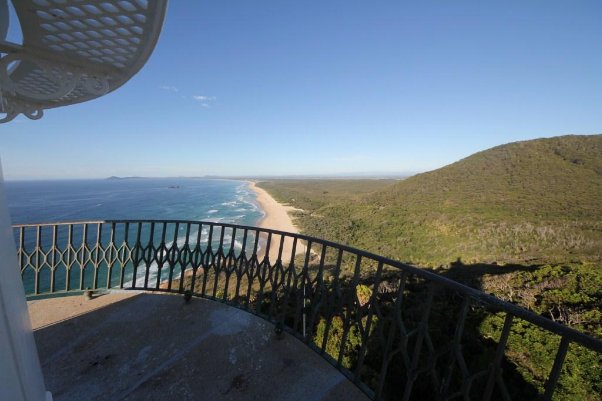
Figure 4. View of Hat Head National Park from lighthouse tower (© AMSA, 2014)
Fauna and flora
A vast range of native plants and animals have been recorded in the Hat Head National Park. The Smoky Range is an established habitat for a koala population and this habitat is protected under a Koala Management Plan.
Bird species recorded in or around Hat Head National Park include:
- little tern (Sternula albifrons) – listed as an endangered species
- osprey (Pamdion haliaetus)
- terek sandpiper (Xenus cinereus)
- pied oyster-catcher (Haematopus longirostris)
- brahiminy kite (Haliastur indus)
- white-bellied sea eagle (Haliaectus leucogaster)
- whimbrel (Numenius phaeopus)
- sharp-tailed sandpiper (Calidris acuminata)
- common sandpiper (Actitus hypoluecos)
- latham’s Snipe (Gallinago hardwickii)
- wood sandpiper (Tringia glareola)
- common greenshank (Tringia nebularia)
- marsh sandpiper (Tringia stagnatalis)
- rainbow bee-eater (Merops ornatus)
Red-necked and swamp wallabies, grey kangaroos and sugar gliders are frequent visitors to the precinct and Hat Head National Park is one of only two locations the regent skipper butterfly is found. Kookaburras, grey-headed flying-foxes and short-beaked echidnas are also found around the lightstation precinct.
Over 500 plant species have been identified and recorded in Hat Head National Park. Most commonly found around the lightstation precinct are the native plants black sheoak (Allocasuarina littoralis) and grass tree (Xanthorrea spp.)[vi].
Further information on the flora and fauna of Hat Head National Park can be obtained from the NPWS webpage.[vii]
2.3 Lease and ownership
AMSA leases the Smoky Cape Lighthouse and surrounding land from the Minister administering the National Parks and Wildlife Act 1974 (NSW). The AMSA lease consists of two parcels of land:
- Lot 1: DP847754
- Lot 2: DP847754
The current lease was signed on 9 July 1998 for the period from 1 July 1997. There is an option to renew for a further 25 years. Due to public interest, a tourist licence was signed between AMSA and the NSW Minister for Environment on 1 July 1997 with the option to renew for a further 25 years. This licence permits the access of no more than ten tourists inside the lighthouse at a time.

Figure 5. Map of AMSA lease (Map data: Esri, DigitalGlobe, GeoEye, Earthstar Geographics, CNES/Airbus DS, USDA, USGS, AEX, Getmapping, Aerogrid, IGN, IGP, swisstopo, and the GIS User Community)

Figure 6. Smoky Cape Lightstation, NSW State Heritage Register Plan 2953, Heritage NSW, 1994 (© State of New South Wales Department of Premier and Cabinet)
2.4 Listings
The table below details the various heritage listings of the Smoky Cape Lightstation.
Register | ID |
Commonwealth Heritage List | 105604[viii] |
New South Wales Heritage Register | 01007[ix] |
2.5 Access
Smoky Cape Lightstation is readily accessible by vehicle via Lighthouse Road. A parking lot is available for use at the base of the lightstation. Further vehicle access is reserved for authorised personnel only.
Members of the general public are required to walk the remaining way to the lighthouse itself. General public access inside the lighthouse is permitted through guided tours only.
Walking access is available along the Smoky Cape Walking Track (2.2 km), the Jack Perkins Walking Track (2 km return), and the Little Bay to Smoky Cape Walking Track (10 km). All three tracks fall within the Hat Head National Park and terminate at the lightstation.

Figure 7. Site access to Smoky Cape Lightstation (© AMSA, 2014)

3. History
3.1 General history of lighthouses in Australia
The first lighthouse to be constructed along Australian soil was Macquarie Lighthouse, located at the entrance to Port Jackson, NSW. First lit in 1818, the cost of the lighthouse was recovered through the introduction of a levy on shipping. This was instigated by Governor Lachlan Macquarie, who ordered and named the light.
The following century oversaw the construction of hundreds of lighthouses around the country. Constructing and maintaining a lighthouse were costly ventures that often required the financial support of multiple colonies. However, they were deemed necessary aids in assisting the safety of mariners at sea. Lighthouses were firstly managed by the colony they lay within, with each colony developing their own style of lighthouse and operational system. Following Federation in 1901, which saw the various colonies unite under one Commonwealth government, lighthouse management was transferred from state hands to the Commonwealth Lighthouse Service.
Lamps and optics – an overview
Lighthouse technology has altered drastically over the centuries. Eighteenth century lighthouses were lit using parabolic mirrors and oil lamps. Documentation of early examples of parabolic mirrors in the United Kingdom, circa 1760, were documented as consisting of wood and lined with pieces of looking glass or plates of tin. As described by Searle, ’When light hits a shiny surface, it is reflected at an angle equal to that at which it hit. With a light source is placed in the focal point of a parabolic reflector, the light rays are reflected parallel to one another, producing a concentrated beam’.
In 1822, Augustin Fresnel invented the dioptric glass lens. By crafting concentric annular rings with a convex lens, Fresnel had discovered a method of reducing the amount of light absorbed by a lens. The Dioptric System was adopted quickly with Cordouran Lighthouse (France), which was fitted with the first dioptric lens in 1823. The majority of heritage-listed lighthouses in Australia house dioptric lenses made by others such as Chance Brothers (United Kingdom), Henry-LePaute (France), Barbier, Bernard & Turenne (BBT, France) and Svenska Aktiebolaget Gasaccumulator (AGA of Sweden). These lenses were made in a range of standard sizes, called orders—see ‘Appendix 2. Glossary of lighthouse terms relevant to Smoky Cape Lighthouse’.
Early Australian lighthouses were originally fuelled by whale oil and burned in Argand lamps, and multiple wicks were required in order to create a large flame that could be observed from sea. By the 1850s, whale oil had been replaced by colza oil, which was in turn replaced by kerosene, a mineral oil.
In 1900, incandescent burners were introduced. This saw the burning of fuel inside an incandescent mantle, which produced a brighter light with less fuel within a smaller volume. Light keepers were required to maintain pressure to the burner by manually pumping a handle as can be seen in Figure 8.

| 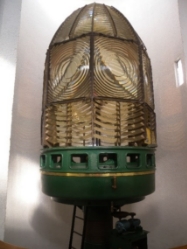
|
Figure 8. Incandescent oil vapour lamp by Chance Brothers (Source: AMSA) | Figure 9. Dioptric lens on display at Narooma (Source: AMSA) |
In 1912, Swedish engineer Gustaf Dalén, was awarded the Nobel Prize in physics for a series of inventions relating to acetylene-powered navigation lights. Dalén’s system included the sun valve, the mixer, the flasher, and the cylinder containing compressed acetylene. Due to their efficiency and reliability, Dalén’s inventions led to the gradual de-staffing of lighthouses. Acetylene was quickly adopted by the Commonwealth Lighthouse Service from 1915 onwards.
Large dioptric lenses, such as that shown in Figure 9, gradually decreased in popularity due to cost and the move towards unmanned automatic lighthouses. By the early 1900s, Australia had stopped ordering these lenses with the last installed at Eclipse Island in Western Australia in 1927. Smaller Fresnel lenses continued to be produced and installed until the 1970s when plastic lanterns, still utilising Fresnel’s technology, were favoured instead. Acetylene remained in use until it was finally phased out in the 1990s.
In the current day, Australian lighthouses are lit and extinguished automatically using mains power, diesel generators, and solar-voltaic systems.

Figure 10. Dalén’s system – sunvalve, mixer, flasher (Source: AMSA)
3.2 The Commonwealth lighthouse service
When the Australian colonies federated in 1901, it was decided that the new Commonwealth Government would be responsible for coastal lighthouses. This included only the major lights used by vessels travelling from port to port, not the minor lights used for navigation within harbours and rivers. There was a delay before this new arrangement came into effect and the existing lights continued to be operated by the states.
Since 1915, various Commonwealth departments have managed lighthouses. The Australian Maritime Safety Authority (AMSA), established under the Australian Maritime Safety Authority Act 1990 (Cth), is now responsible for operating Commonwealth lighthouses and other marine aids to navigation, along with its other functions.
3.3 New South Wales lighthouse service administration
The table below details the timeline of lighthouse service administration from 1915 to present.
Time Period | Administration |
1915 – 1927 | Lighthouse Branch No. 3 District New South Wales, Victoria and Tasmania, Sydney headquarters. |
1927 – 1963 | Deputy Director of Lighthouses and Navigation, New South Wales. |
1963 – 1972 | Department of Shipping and Transport, Regional Controller, New South Wales. |
1972 – 1977 | Department of Transport [III], New South Wales Region / (from 1973) Surface Transport Group, New South Wales region. |
1977 – 1982 | Department of Transport [III], New South Wales region. |
1982 – 1983 | Department of Transport and Construction, regional office, New South Wales. |
1983 – 1987 | Department of Transport [IV], New South Wales regional office. |
1987 – 1990 | Department of Transport and Communications (Transport Group), New South Wales regional office. |
1991 – | Australian Maritime Safety Authority (AMSA). |
3.4 Smoky Cape: a history
Aboriginal history
Further consultation with traditional stakeholders will be undertaken to gain a greater understanding of Smoky Cape’s history. This plan will be updated in future versions to reflect the accumulation of information.
Early European history
On 13 May, 1770, Captain James Cook aboard the Endeavour passed a cape in the coastline. Cook described in his journal “a point or headland, on which we saw fires that produced a great quantity of smoke, which occasioned my giving it the name Smoky Cape”[x].
The region was left unimpeded by European interaction until 1816 when the Trial, a ship hijacked by escaped convicts from Port Jackson, NSW, was wrecked at Trial Bay (located approximately 13 km north of Smoky Cape). Indigenous inhabitants of the region reported the wrecking to nearby European settlers. A year later in 1817, an expedition party headed by explorer John Oxley visited the area.
European settlement of Trial Bay and surrounding regions accelerated in 1836 which saw the dispossession of Indigenous inhabitants from their lands[xi].
3.5 Planning a lighthouse
Why Smoky Cape?
Early into European occupation of the region, Trial Bay was recognised for its favourable position as a haven for passing ships owing to the protection it offered from southerly gales, and due to its midway position between Sydney and Brisbane. Throughout the course of the 19th century, the various colonies of New South Wales were heavily dependent on the safe passage of goods and trade via shipping routes along the coastline. However, shipwrecks were both frequent and disastrous in the region. In 1864, the ketch Woolloomooloo was wrecked in Trial Bay and three men were killed. In 1875, the brig Annie Ogle was wrecked and a total of nine people were killed.
By telegram we learn that a portion of the above- named vessel had been picked up at Smoky Cape; among the debris was the sterns of two boats, painted similar to those onboard the ill-fated brig, and with the ship’s and former masters names painted on one. Also, a portion of a cabin door to the handle of which was attached Captain McDonald’s certificate, thus leaving not a shadow of a doubt as to the fate of the crew. The Annie Ogle was a fine brig of 210 tons, built and owned by Messers. Rountree and Co. of this city, and was on her second voyage. She sailed from Sydney on the 23rd February, in ballast, bound to Grafton, there to load a cargo of hardwood for Lyttelton. Since then nothing has been heard of her….
…she has therefore probably headed to the southward, and in the thick weather that prevailed gone to the Solitarys, which would account for portions of the wreck getting on the beach at Smoky Cape[xii].
Various other ships were wrecked in the Trial Bay area and along the accompanying headland which affected the credibility of coastal trade and shipping in NSW.
It was in 1873 that the need for a lighthouse on Smoky Cape was first addressed by the principal officers of the Australian Colonies Marine Departments. However, no action was taken following this initial request. In 1884, the Shipmasters and Officers Association presented to the government requests to build lighthouses at both Smoky Cape and Norah Head. It wasn’t until 1886 that a Mr Alexander Kethel, Member for West Sydney, passed a resolution in the Legislative Assembly for a light at Smoky Cape. Kethel argued that the erection of a light at Smoky Cape would benefit the increase of coastal trade and navigation in New South Wales.
The lighthouse would serve a two-fold purpose; first, as a landmark and secondly, as a guide for the navigation of ships. He [Kethel] had been induced to bring forward that motion by a great number of ship masters, and the erection of a lighthouse had been urged in some petitions presented to the House[xiii].
Design
James Barnet, colonial architect for New South Wales, was appointed as head architect and designed the blueprints for the proposed Smoky Cape Lighthouse. Barnet, alongside the Marine Board, surveyed Smoky Cape in 1889 and selected the site, then Barnet designed a mass concrete, octagonal plan form lighthouse (See Figure 14).
James Barnet (1827-1904) 
|
Born in 1827, Barnet studied drawing, design and architecture in London before he and his family migrated to Australia c. 1854. Appointed Clerk of Works for Sydney University, Barnet later joined the Colonial Architect’s Office in 1860. By 1865, he was named Colonial Architect, a position he held until his retirement in 1890. In that timeframe, Barnet was responsible for the architectural design of numerous public works including allegedly 15 lighthouses. His design style, adopted from Francis Greenway’s Macquarie Light (1818), served as the quintessential NSW style until the end of the 19th century. |
Figure 11. James Barnet (n.d)
Barnet’s plans also included the proposed keepers’ cottages to the west of the lighthouse tower (See Figure 19). In keeping with the proposed fabric of the lighthouse, the cottages were designed to be constructed of mass concrete with galvanised iron roofs.
In 1890, an administrative reshuffle in the NSW government oversaw the termination of the colonial architect’s office. As a direct result, the responsibility for constructing the Smoky Cape Lighthouse under Barnet’s original design was tasked to Cecil W Darley, engineer-in-chief of the Harbours and Rivers Department[xiv].
Construction
Tenders were called for the erection of a lighthouse tower and annexe, a head keeper’s and assistant keepers’ residences, coach house, stables and retaining walls, in both December 1888 and January 1889. The contract was awarded to Messers Oakes and Co. and construction required excavation and levelling of the site due to the Cape’s configuration. Granite for the structure was quarried locally.
During construction of the Smoky Cape Lightstation, Oakes died suddenly onsite. The contract was left to his executors to complete under direction of Darley. Work was completed within the budgeted £16,800, and the light was first exhibited 15 April 1891.
The official opening ceremony was celebrated 29 April 1891, and attended by Darley and various members of the Marine Board[xv].

Figure 12. Design plan for Smoky Cape Lighthouse, 1889. Image courtesy of the National Archives of Australia. NAA: A9568, 1/17/2 (© Commonwealth of Australia, National Archives of Australia)

Figure 13. Site plan for Smoky Cape Lightstation, 1889. Image courtesy of the National Archives of Australia. NAA: A9568, 1/17/1 (© Commonwealth of Australia, National Archives of Australia)
Equipment when built
Upon completion, Smoky Cape Lighthouse stood as a concrete-mass plan lighthouse in the typical James Barnet style. Its lantern consisted of a First Order Chance Brothers 920mm focal radius, nine panel catadioptric revolving lens mounted on a clock driven roller bearing pedestal housed in a 12’ 1½ diameter lantern. The original light source was a Trinity House pressure lamp (Chance Bros). The nine lens panel made one revolution every 90 seconds with an intensity of 100,000 candelas (cd) and a range of approximately 25 nautical miles.
Fittings for a red auxiliary light were installed within the lighthouse, however there is little evidence to suggest this 5th Order 187mm lens was ever properly installed at Smoky Cape, let alone lit. The lens itself was eventually installed in the Cape Byron lighthouse upon completion of its construction in 1901[xvi].
3.6 Lighthouse keepers
The first head lightkeeper stationed at Smoky Cape was Captain Robert Kelly, flanked by his two assistants James H Vanderwood and David MacFarlane.
The keepers, who resided with their families in the onsite keeper’s cottages and maintained limited contact with the surrounding communities, worked in shifts manning the light each night.
The keepers were also instrumental in a number of disastrous events that occurred around the lighthouse. Shipwrecks were not uncommon on the cape and the lighthouse often served as the first point of call for aid. On 12 November 1903, the ketch Sir George was struck by a storm just north of the cape. Crew were washed overboard and two seamen were drowned. Headkeeper, John Skelton, with his assistant keeper William Chapman, risked their lives attempting to rescue the men. After dragging the captain and two remaining crewmen to shore, both Skelton and Chapman were awarded a silver medal and Certificate of Merit for Bravery for their quick-thinking and courageous efforts[xvii].
A list of those that served on the Smoky Cape Lightstation is incomplete.
3.7 Chronology of major events
The table below details the various events to have impacted Smoky Cape Lightstation in the decades following its construction in 1891.
Date | Event Details |
1891 | Smoky Cape Lighthouse built. |
1903 | Ketch, the Sir George, wrecked off Smoky Cape. Survivors rescued by lighthouse staff – two fatalities[xviii]. |
1915 | Commonwealth takes control of state-owned lighthouses. |
1914-1918 | Visitors prohibited from entering lighthouse grounds throughout the duration of World War I[xix]. |
1937 | Two launches, the Yvonne and the Jacqueline, flounder off Smoky Cape. Man thrown overboard and bitten by a shark. Survivors nursed by lighthouse staff – no fatalities[xx]. |
1939-1945 | Precinct used for military activities and for light gun emplacement[xxi]. |
1947 | Launch sinks at Smoky Cape – two fatalities[xxii]. |
1952 | Telephones installed in tower and cottages[xxiii]. |
1962 | Light converted to mains electric operation. Two stand-by diesel generators installed. Reduced to two lightkeepers. |
Circa 1970s | Radio mast added to the pavilion[xxiv]. |
1972 | Gazettal of Hat head National Park |
1980 | Walking tracks from cape to nearby beaches and South West Rocks established by NPWS. Smoky Cape Lighthouse listed on the Register of the National Estate. |
1987 | Road to lighthouse sealed[xxv]. |
1988 | Smoky Cape Lighthouse fully automated. |
1995 | Lightstation de-manned. |
1997 | Smoky Cape Lighthouse precinct passed to NPWS[xxvi]. |
1999 | Smoky Cape Lighthouse listed on the NSW State Heritage Register. |
2004 | Smoky Cape Lighthouse listed on the Commonwealth Heritage List. |
2012 | Lighthouse struck by lightning – lantern rotation failure. |
3.8 Changes and conservation over time
Smoky Cape Lighthouse has encountered a number of technological adaptations and conservation works to improve the station as a working AtoN. In this section, the Brewis report, alterations to the light, and conservation works carried out over time have been detailed.
The Brewis Report (1912)
Commander CRW Brewis, retired naval surveyor, was commissioned in 1911 by the Commonwealth Government to report on the condition of existing lights and to recommend any additional ones.
Brewis visited every lighthouse in Australia between June and December 1912 and produced a series of reports published in their final form in March 1913. These reports were the basis for future decisions. Brewis’ visit to the Smoky Cape Lighthouse yielded no recommendations, but captured the light’s character as it was in 1912.
Smoky Cape Light |
45 miles from South Solitary Island. Lat. 30º 56’ S., Long. 153º 05’ E., Chart No. 1025.- Established 1891. Last altered 1912. Character: One white, dioptric, 100,000 c.p. Group flashing, showing three flashes every thirty seconds, thus:- Flash, two seconds; eclipse, two seconds; flash, two seconds; eclipse, two seconds; flash, two seconds; eclipse, twenty seconds. Illuminant. vaporized kerosene; 55 mm. incandescent mantle. Octagonal stone tower, 32 feet, painted white. Height of focal plane, 420 feet Visibility: From seaward, in clear weather, for a distance of about 28 nautical miles. Optical Apparatus: Chance Bros., 189-. Three groups of triple-flashing panels. Focal radius, 36 inches. One revolution every ninety seconds. Condition and State of Efficacy: The tower, apparatus, and quarters are in good state of repair, and are serviceable. Three light-keepers are stationed here. Communication: By road with Jerseyville (6 miles) and South West Rocks (6 miles), Gladstone (15 miles), Kempsey (20 miles). Connected by telephone with South West Rocks Pilot Station and Kempsey, and thence to main telegraph system. Mails twice weekly. Government stores once yearly by coastal steamer. Illuminating oil as required. Provisions, &c, by coastal steamer weekly. Fogs: Few fogs occur in this locality. They are experienced chiefly in the early morning. Soundings: The soundings on the Admiralty Chart are of a complete and suitable nature, the 20 fathom contour line being ¾ mile seaward, and the 30-fathom contour 1 ½ miles. A vessel can assure her safety by maintaining a depth of at least 30 fathoms. RECOMMENDATION: Nil |
Alterations to the Light
Over the centuries, optic technology used in lighthouses has evolved to improve marine safety for coastal shipping. The alterations made unto the Smoky Cape light are listed below:
Date | Alteration |
1905 | Intensity: 222,000 cd. |
1912 | Original burner replaced with a Ford-Schmidt 55mm incandescent vaporised kerosene burner. |
1 April 1923 | New autoform mantle introduced. Intensity: 316,000 cd. |
13 Oct 1962 | Smoky Cape light converted to mains electric operation with two (2) 1.5KVA stand by diesel generators. Intensity: 1,000,000 cd. |
Circa 1960s | Original clock weights removed from tower. Original optic drive and pedestal altered. |
1974 | 1000 W 100 V Tungsten halogen lamp installed. Intensity: 1,000,000 cd. |
1988 | Light fully automated. |
2016 | Light upgraded to LED source. |
See Appendix 3 for details on the current light installed at Smoky Cape.
Conservation Works
The table below details the timeline for major rectification works carried out on the lighthouse.
Date | Works Completed |
1938 | Dome reconditioned and lantern house reglazed. New gears installed. Temporary light in operation during these works21. |
1962 | Alterations to two windows on the eastern elevation of the lighthouse22. |
Circa 1970s | Original cast iron guttering and downpipes of pavilion replaced23. |
1990 | Roof cladding of pavilion replaced with zincalume. |
2007 | Repainting of tower, external. |
2009 | Repainting of tower, internal. |
2018 | Asbestos removal – entrance doorway. Materials replaced with fibre cement sheeting. |
3.9 Summary of current and former uses
From its construction in 1891, the Smoky Cape Lighthouse has been used as a marine AtoN for mariners at sea. Its AtoN capabilities remain its primary use.
Smoky Cape Lighthouse developed as a key tourism site over recent decades following the de-inhabitation of on-site lightkeepers. It presented an opportunity for guided tours inside the lighthouse. This touristic utilisation remains secondary to its primary use as a working AtoN.
3.10 Summary of past and present community associations
Aboriginal associations
Further consultation with traditional stakeholders will be undertaken to gain a greater understanding of the past and present associations held across the region.
Local, National, and International associations
The area is frequented by visitors, both local and incoming tourists, due to its historical, mythological and aesthetic associations. It’s location within the Hat Head National Park along the various walking tracks, further cements these community associations. The site’s popularity triggered the introduction of tours inside the lighthouse.
3.11 Unresolved questions of historical conflicts
The supposed use of the 5th Order Auxiliary light remains unknown. Fittings associated with its intended installation are still found in the lighthouse to this day, however no comment was ever made on its use save for one reference in an 1898 paper which stated “A subsidiary red light was shown from the first floor of the tower and covered the danger of Fish Rock”[xxvii]. The lens was eventually installed in the Cape Byron lighthouse in 1901.
3.12 Recommendations for further research
Research on past lighthouse keepers of the Smoky Cape Lighthouse may be beneficial in determining the full extent of the social value placed on the site within the surrounding communities of Arkoon and Trial Bay. Additionally, archaeological investigation of the site may reveal further information on prehistoric and historic uses of Smoky Cape to broaden understandings of the site’s intrinsic value[xxviii].

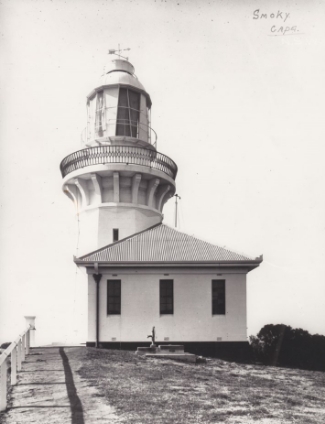 Figure 14. Smoky Cape Lighthouse, 1917. Image courtesy of the National Archives of Australia. NAA: A6247, 13/2 (© Commonwealth of Australia, National Archives of Australia)
Figure 14. Smoky Cape Lighthouse, 1917. Image courtesy of the National Archives of Australia. NAA: A6247, 13/2 (© Commonwealth of Australia, National Archives of Australia)

4. Fabric
4.1 Fabric register
The cultural significance of Smoky Cape Lighthouse resides in both its fabric and intangible aspects, such as the meanings people ascribe to it, and the connections to other places and things. The survival of its cultural value depends on a well-informed understanding of what is significant, and on clear thinking about the consequences of change. The Burra Charter sets out good practice for conserving cultural significance.
Below, each part of the lighthouse is listed and the description, condition and significance of each part is discussed. Criterion listed under ‘Heritage Significance’ refer to the criterion satisfied within the specific Commonwealth heritage listing (see Section 5.1)
(Section 4.1 and 4.2 – Photo source: AMSA)
Lighthouse feature: Lantern roof


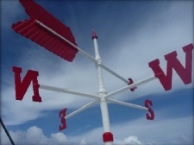


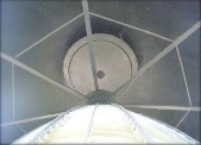
© AMSA 2020
Description and condition
1891 Chance Bros. part-spherical dome of copper sheets lapped and screwed to ribs.
- Ribs – Chance Bros cast iron radial ribs.
- Inner skin – copper sheets screw fixed to ribs.
- Ventilator – drum type with wind vane attached.
- Wind vane – intact and complete with cardinal direction indicators.
- Lightning conductor – vertical pole beside ventilator, with three spikes at top, and two braces to ventilator, eight vertical spikes attached near the gutter.
- Gutter – polygonal fabricated gutter attached to ring of cast iron pieces bolted together.
- Handrails – one circular hand rail attached to lantern roof, another attached to top of ventilator drum.
- Ladder rail – attached to underside of gutter.
- External ladder – curved iron ladder fixed to outside of roof.
- Drip tray – copper dish suspended under ventilator.
Finish | painted |
Condition | intact and sound |
Integrity | high |
Significance | high |
Maintenance | keep in service, prepare and repaint at normal intervals |
Rectification works | none |
Heritage significance: High
The lantern roof is an original and essential part of a lighthouse associated with the development of 19th century navigational aids along the NSW coast (criterion a).
The lantern roof contributes to the aesthetic value of the lighthouse (criterion e).
Lighthouse feature: Lantern glazing

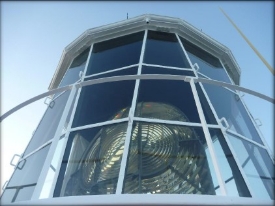
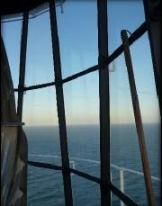
© AMSA 2020
Description and condition
1891 Chance Bros.
- Panes – flat trapezoidal glass, three tiers. Blank panes to landward side.
- Astragals – Chance Bros vertical and horizontal astragals, bolted to gutter ring at top, and to lantern base below.
- Handholds – two sets, fixed to cover strips.
Finish | astragals and glazing strips painted |
Condition | intact and sound |
Integrity | high |
Significance | high |
Maintenance | keep in service, reglaze as necessary, prepare and repaint at normal intervals |
Rectification works | none |
Heritage significance: High
The lantern glazing is an essential part of a lighthouse associated with the development of 19th century navigational aids along the NSW coast (criterion a).
Lighthouse feature: Internal catwalk




© AMSA 2020
Description and condition
1891 Chance Bros cast iron lattice floor panels supported on solid cast iron brackets bolted to the upper section of the lantern base.
- Ladder – fixed ladder with cast iron treads on wrought iron strings.
Finish | painted |
Condition | intact and sound |
Integrity | high |
Significance | high |
Maintenance | keep in service, prepare and repaint at normal intervals |
Rectification works | none |
Heritage significance: High
The internal catwalk is an original and essential part of a lighthouse associated with the development of 19th century navigational aids along the NSW coast (criterion a).
Lighthouse feature: External catwalk



© AMSA 2020
Description and condition
1891 Chance Bros cast iron lattice floor panels supported on openwork cast iron brackets bolted to the lantern base.
- Handrail – wrought iron stanchions and rail, bolted to floor.
Finish | painted |
Condition | intact and sound |
Integrity | high |
Significance | high |
Maintenance | keep in service, prepare and repaint at normal intervals |
Rectification works | none |
Heritage significance: High
The external catwalk is an original and essential part of a lighthouse associated with the development of 19th century navigational aids along the NSW coast (criterion a).
The external catwalk contributes to the aesthetic value of the lighthouse (criterion e).
Lighthouse feature: Lantern base



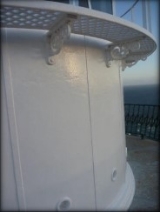

© AMSA 2020
Description and condition
1891 Chance Bros, cylindrical in form. Curved panels of cast iron fixed together.
- Internal lining – curved iron plates screwed to the outer cast iron panels.
- Vents – round external air inlets cast as part of wall panels. Large round copper alloy regulators below internal catwalk, small ones above.
- Door – iron framed and sheeted door hung on copper alloy hinges. Copper alloy mortise lock with copper alloy bar handles inside and out.
Finish | painted |
Condition | intact and sound |
Integrity | high |
Significance | high |
Maintenance | keep in service, prepare and repaint at normal intervals |
Rectification works | none |
Heritage significance: High
The lantern base is an original and essential part of a lighthouse associated with the development of 19th century navigational aids along the NSW coast (criterion a).
Lighthouse feature: Lantern floor




© AMSA 2020
Description and condition
1891 floor of iron checkerplate panels supported on rolled iron I section beams built into the concrete cornice/balcony floor.
Finish | painted |
Condition | intact and sound |
Integrity | high |
Significance | high |
Maintenance | keep in service, prepare and repaint at normal intervals |
Rectification works | none |
Heritage significance: High
The lantern floor is an original and essential part of a lighthouse associated with the development of 19th century navigational aids along the NSW coast (criterion a).
Lighthouse feature: Lens assembly

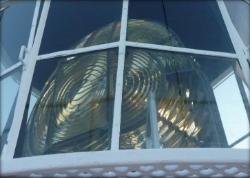

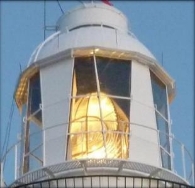
© AMSA 2020
Description and condition
1891 Chance Bros 920mm focal radius triple-flashing nine-panel catadioptric rotating lens assembly of glass and gunmetal, on cast iron table.
Condition | intact and sound |
Integrity | high |
Significance | high |
Maintenance | keep in service, clean at normal intervals |
Rectification works | none |
Heritage significance: High
The lens assembly is an original and essential part of a lighthouse associated with the development of 19th century navigational aids along the NSW coast (criterion a).
The original 1891 Chance Bros lens is maintained within the lighthouse’s lantern house (criterion b).
The lantern house and lens assembly maintain principal characteristics of late nineteenth century industrial maritime technology (criterion d).
The lens assembly contributes to the aesthetic value of the lighthouse (criterion e).
Lighthouse feature: Light source
 © AMSA 2021
© AMSA 2021
Description and condition
Sealite SL-LED-324-W, 12 sided- 36 LED light source mounted on original cast iron pillar.
Condition | not assessed |
Integrity | high |
Significance | low |
Maintenance | not assessed |
Rectification works | none |
Heritage significance: Low
Lighthouse feature: Pedestal



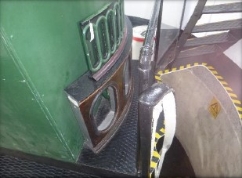 © AMSA 2020
© AMSA 2020
Description and condition
1962 CLS bearing, electric drive, enclosure and pedestal.
- Bearing – cast iron base, main spindle supported on ball races.
- Drive – train of bronze spur gears, clutch, gearbox and electric motor.
- Enclosure – later enclosure of clear acrylic sheet in aluminium frame.
- Pedestal – enclosed box with steel angle frame sheeted with steel plate, on steel base projecting on two opposite sides.
- Loose pieces – two cast iron components sitting on pedestal base, apparently parts of the 1891 lens carrier and lamp table.
Condition | intact and sound |
Integrity | high |
Significance | high |
Maintenance | keep in service, prepare and repaint pedestal at normal intervals |
Rectification works | none |
Heritage significance: High
The pedestal is a historic and essential part of a lighthouse associated with the development of 19th century navigational aids along the NSW coast (criterion a).
Lighthouse feature: Balcony floor


 © AMSA 2020
© AMSA 2020
Description and condition
1891 granite slab floor, supported on the top of the concrete tower walls and on granite brackets. Resilient joint caulking.
Finish | bare stone top and edge painted soffit |
Condition | intact and sound |
Integrity | medium |
Significance | high |
Maintenance | keep in service, replace joint caulking at normal intervals |
Rectification works | none |
Heritage significance: High
The balcony floor is an original and essential part of a lighthouse associated with the development of 19th century navigational aids along the NSW coast (criterion a).
Lighthouse feature: Balcony balustrade

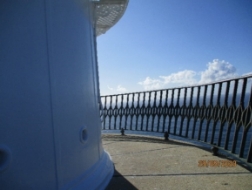 © AMSA 2020
© AMSA 2020
Description and condition
1891 gunmetal railing, with closely spaced balusters of rectangular section canted outward, cruciform stiffeners bolted to balusters, rectangular bottom rail, half-round top rail, turned bulbous fixing bolts at bottom.
Finish | bare metal |
Condition | intact and sound |
Integrity | high |
Significance | high |
Maintenance | keep in service |
Rectification works | none |
Heritage significance: High
The balcony balustrade is an original and essential part of a lighthouse associated with the development of navigational aid along the NSW coast (criterion a).
The balcony balustrade contributes to the aesthetic value of the lighthouse (criterion e).
Lighthouse feature: Walls
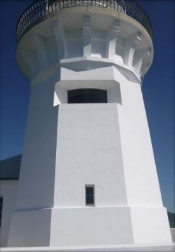
 © AMSA 2020
© AMSA 2020
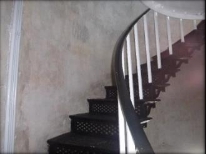

Description and condition
1891 tapered octagonal walls of mass concrete, cement rendered outside and plastered inside.
Finish | outside: painted inside: bare plaster |
Condition | intact and sound |
Integrity | high |
Significance | high |
Maintenance | keep in service, prepare and repaint at normal intervals |
Rectification works | none |
Heritage significance: High
The tower walls are an original and essential part of a lighthouse associated with the development of 19th century navigational aids along the NSW coast (criterion a).
Smoky Cape is one of only three lighthouses composed of mass concrete construction in NSW (criterion b).
The form and fabric of the tower walls is an example of late-nineteenth century industrial maritime technology (criterion d).
The tower walls contribute to the aesthetic value of the lighthouse (criterion e).
The design of the tower walls stands as an example of the James Barnet style, an influential figure within the NSW colony (criterion h).
Lighthouse feature: Windows


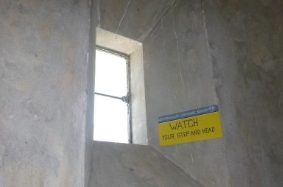
 © AMSA 2020
© AMSA 2020
Description and condition
Six 1891 windows with gunmetal casement sashes, hinges, latches and frames, built into the concrete walls. One fixed curved glass window for former auxiliary light.
Finish | frames and sashes: painted glass: clear |
Condition | intact and sound |
Integrity | high |
Significance | high |
Maintenance | keep in service, prepare and repaint at normal intervals |
Rectification works | none |
Heritage significance: High
The windows are an original and essential part of a lighthouse associated with the development of 19th century navigational aids along the NSW coast (criterion a).
Lighthouse feature: Door
 © AMSA 2020
© AMSA 2020
Description and condition
The doors into the tower at ground floor are timber framed and sheeted doors. Brass door furniture.
Finish | polished |
Condition | intact and sound |
Integrity | high |
Significance | high |
Maintenance | keep in service, prepare and maintain polish at normal intervals |
Rectification works | none |
Heritage significance: High
The tower door is an essential part of a lighthouse associated with the development of 19th century navigational aids along the NSW coast (criterion a).
Lighthouse feature: Weight tube

 © AMSA 2020
© AMSA 2020
Description and condition
1891 riveted iron tube in the centre of the tower, between the lantern floor and the ground floor.
Finish | painted |
Condition | intact and sound |
Integrity | medium |
Significance | high |
Maintenance | preserve, prepare and repaint at normal intervals |
Rectification works | none |
Heritage significance: High
The weight tube is an original and essential part of a lighthouse associated with the development of 19th century navigational aids along the NSW coast (criterion a).
Lighthouse feature: Intermediate floors

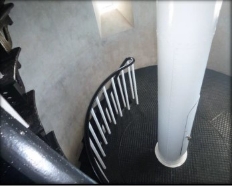

 © AMSA 2020
© AMSA 2020
Description and condition
1891 cast iron plate floor on rolled iron beams built into tower walls.
Finish | painted |
Condition | intact and sound |
Integrity | high |
Significance | high |
Maintenance | keep in service, prepare and repaint at normal intervals |
Rectification works | none |
Heritage significance: High
The intermediate floors are both original and essential parts of the lighthouse (criterion a).
Lighthouse feature: Stairs
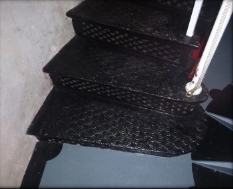

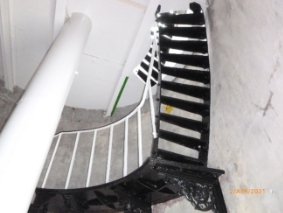 © AMSA 2020
© AMSA 2020
Description and condition
1891 geometric stair with cast iron treads attached to the tower walls.
- Balustrade – wrought iron handrail and stanchions.
Finish | painted |
Condition | intact and sound |
Integrity | high |
Significance | high |
Maintenance | keep in service, prepare and repaint at normal intervals |
Rectification works | none |
Heritage significance: High
The internal tower stairs are both an original and essential part of the lighthouse (criterion a).
Lighthouse feature: Ground floor


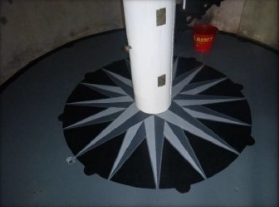 © AMSA 2020
© AMSA 2020
Description and condition
1891 concrete slab.
Finish | painted |
Condition | intact and sound |
Integrity | high |
Significance | high |
Maintenance | keep in service, prepare and repaint at normal intervals |
Rectification works | none |
Heritage significance: High
The ground floor is both an original and essential part of the lighthouse (criterion a).
Lighthouse feature: Pavilion room floor

 © AMSA 2020
© AMSA 2020
Description and condition
1891 concrete floor slab on ground.
Finish | Corridor: painted finish. Office: lino finish. Equipment room: Central plinth (diesel generator) and service duct still in place ceramic tile finish. |
Condition | Intact and sound. |
Integrity | high |
Significance | high |
Maintenance | keep in service, prepare and repaint at normal intervals |
Rectification works | none |
Heritage significance: High
The pavilion room floor is both an original and essential part of the lighthouse (criterion a).
Lighthouse feature: Pavilion room walls
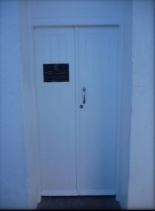
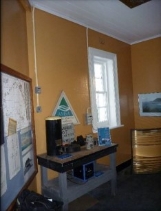

 © AMSA 2020
© AMSA 2020
Description and condition
1891 concrete walls enclosing a corridor and two other rooms, rendered outside and plastered inside.
- Windows – six double hung timber windows.
- Doors – timber framed and sheeted doors.
Finish | outside: painted inside hallway: bare plaster two internal rooms: painted |
Condition | intact and sound |
Integrity | high |
Significance | high |
Maintenance | keep in service, prepare and repaint at normal interval |
Rectification works | none |
Heritage significance: High
The pavilion room walls are both original and essential parts of the lighthouse (criterion a).
Lighthouse feature: Pavilion roof
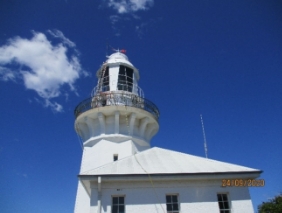
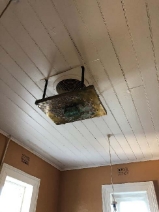 © AMSA 2020
© AMSA 2020
Description and condition
1891 pyramid roof with timber frame, sheeted with 1990 Colorbond Zincalume steel sheeting and eaves gutter. 1891 timber beaded tongue-and groove boarded ceilings.
Finish | painted |
Condition | intact and sound |
Integrity | high |
Significance | high |
Maintenance | keep in service, prepare and repaint at normal intervals |
Rectification works | none |
Heritage significance: High
The pavilion timber frame is both an original and essential part of the lighthouse (criterion a).
Lighthouse feature: Pavilion equipment and fittings

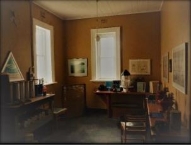

© AMSA 2020
Description and condition
- Corridor – early timber cupboard with two framed and panelled doors.
- Equipment room – batteries and control equipment in locked cabinets; generator on plinth.
- Office – timber cupboard; fixed desk; portable desk.
Condition | intact and sound |
Integrity | high |
Significance | corridor cupboard: high other elements: low |
Maintenance | keep in service |
Rectification works | none |
Heritage significance: High
The pavilion room cupboard fittings are both an original and essential part of the lighthouse (criterion a).
Lighthouse feature: Apron paving
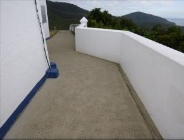
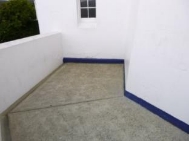

© AMSA 2020
Description and condition
Recent concrete paving around the base of the tower up to the wind break wall.
Finish | trowelled bare concrete |
Condition | sound |
Integrity | high |
Significance | low |
Maintenance | monitor for any cracks/signs of damage to structural integrity |
Rectification works | none |
Heritage significance: Low
Lighthouse feature: Wind break wall

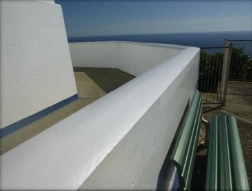
 © AMSA 2020
© AMSA 2020
Description and condition
1891 rendered masonry wind break wall around the apron.
Finish | painted |
Condition | intact and sound |
Integrity | high |
Significance | high |
Maintenance | prepare and repaint at normal intervals |
Rectification works | none |
Heritage significance: High
The wind break wall is both an original and essential part of the lighthouse (criterion a).
Lighthouse feature: Flag locker
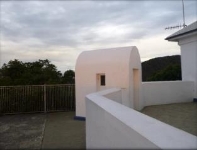
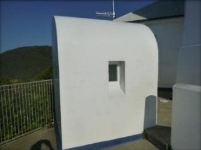

© AMSA 2020
Description and condition
1891 rendered masonry building with a pair of timber framed and sheeted doors and small fixed window.
Finish | painted |
Condition | intact and sound |
Integrity | high |
Significance | high |
Maintenance | prepare and repaint at normal intervals |
Rectification works | none |
Heritage significance: High
The flag locker is both an original and essential part of the lighthouse (criterion a).
4.2 Related object and associated AMSA artefact
There is a collection of related objects/associated artefacts on display within the tower, engine room and display room of the Smoky Cape Lightstation.
Diesel generator | AGA 375mm diameter lens |
 © AMSA 2019 © AMSA 2019
Maximo ID: AR084. __________________________________ Location in lighthouse: Engine room. _______________________________ Condition: Good. __________________________________ |  © AMSA 2019 © AMSA 2019
Maximo ID: AR0242. _______________________________ Location in lighthouse: Engine room. __________________________________ Condition: Good. __________________________________ |
AGA VS10 sunvalve | AGA acetylene flasher |
 © AMSA 2019 © AMSA 2019
Maximo ID: AR0285. ________________________________ Location in lighthouse: Display room. ________________________________ Condition: Good ________________________________ |  © AMSA 2019 © AMSA 2019
Maximo ID: AR0088. ________________________________ Location in lighthouse: Display room. ________________________________ Condition: Good. ________________________________ |
Distillate header tank | FA251 Lantern |
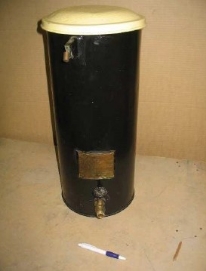 © AMSA 2019 © AMSA 2019
Maximo ID: AR0289. _____________________________ Location in lighthouse: Engine room. ________________________________ Condition: Good. ________________________________ |  © AMSA 2019 © AMSA 2019
Maximo ID: AR0589. _____________________________ Location in lighthouse: Display room. ________________________________ Condition: Good. ________________________________ |
| | |
Life ring “Smoky Cape” | Blanket box |

© AMSA 2019 Maximo ID: AR0492 _________________________________ Location in lighthouse: Tower ground floor. _________________________________ Condition: Good. _______________________________ | 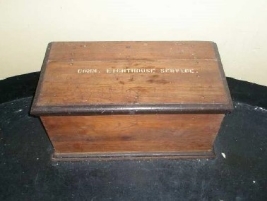
© AMSA 2019 Maximo ID: AR0493. _________________________________ Location in lighthouse: Tower ground floor. _________________________________ Condition: Good. _______________________________ |
Cap with CLS badge | White cabinet |
 © AMSA 2019 © AMSA 2019
Maximo ID: AR0550. _________________________________ Location in lighthouse: Display room. _________________________________ Condition: Good. _________________________________ | 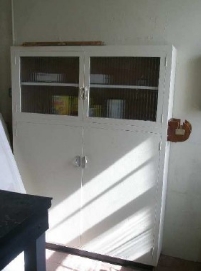 © AMSA 2019 © AMSA 2019
Maximo ID: AR0548. _________________________________ Location in lighthouse: Engine room. _________________________________ Condition: Good. ______________________________ |
| | |
AGA Dalen acetylene mixer | AGA 240mm flasher |
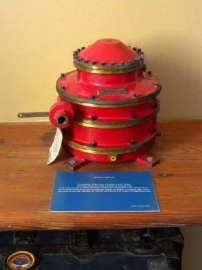 © AMSA 2019 © AMSA 2019
Maximo ID: AR0419.
______________________________ Location in lighthouse: Display room. _________________________________ Condition: Good. _________________________________ |  © AMSA 2019 © AMSA 2019
Maximo ID: AR0392 ______________________________ Location in lighthouse: Display room. _________________________________ Condition: Good. _________________________________ |
| | |
First order lens section ex- Gabo Island | 300mm Lens ex-Bedout Island |
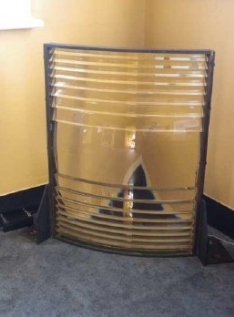
© AMSA 2019 Maximo ID: AR0014 _________________________________ Location in lighthouse: Display room. _________________________________ Condition: Good. _________________________________ | 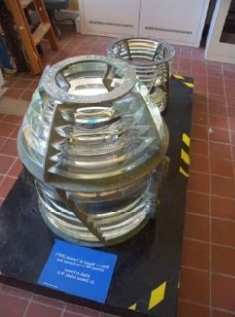
© AMSA 2019 Maximo ID: AR0241 _________________________________ Location in lighthouse: Engine room. _________________________________ Condition: Good. ______________________________ |
| | |
Holmes colour perception lantern | CLS MK IV Lampchanger |

© AMSA 2019 Maximo ID: AR0308 _________________________________ Location in lighthouse: Display room. _________________________________ Condition: Good. _________________________________ | 
© AMSA 2019 Maximo ID: AR0227 _________________________________ Location in lighthouse: Display room. _________________________________ Condition: Good. _________________________________ |
| | |
Blue CLS workbox | Small grey workbench |

© AMSA 2019 Maximo ID: AR0491 _________________________________ Location in lighthouse: Tower ground floor. _________________________________ Condition: Good. ________________________________ | 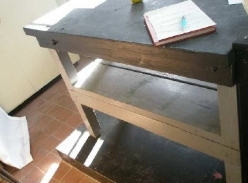
© AMSA 2019 Maximo ID: AR0549 ________________________________ Location in lighthouse: Engine room. ________________________________ Condition: Good. ________________________________ |
| | |
4.3 Comparative analysis
Smoky Cape Lighthouse closely resembles Sugarloaf Point Lighthouse, NSW. It was another of James Barnet’s major projects during his time as colonial architect for New South Wales.
Built in 1875, Sugarloaf Point is a short, rendered brick tower with an original Chance Bros. 1st Order rotating lens assembly and lantern. At 7 metres in height, Sugarloaf competes with the Smoky Cape Lighthouse as one of the shortest lighthouses operated by the Commonwealth.
Apart from the inclusion of an external staircase, Sugarloaf Point’s external tower closely resembles the fabric found at Smoky Cape. The balcony bases for both lighthouses are fixed by stone and granite brackets respectively, and both are fashioned with gunmetal balustrades. Both Smoky Cape and Sugarloaf Point are considered to represent the quintessential Barnet design of the 19th century.

| 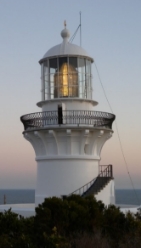
|
Figure 15. Smoky Cape Lighthouse. (© AMSA, 2014) | Figure 16. Sugarloaf Point Lighthouse. (© AMSA, 2009) |

5.Heritage significance
5.1 Commonwealth heritage list – Smoky Cape Lighthouse
The following information is taken directly from the Commonwealth heritage listing for Smoky Cape Lighthouse (Place ID: 105604).
Statement of Commonwealth heritage significance
The following statement of significance is taken directly from Smoky Cape Lighthouse’s Commonwealth heritage listing:
Smoky Cape Lighthouse, established in 1891, is significant for its association with the development of New South Wales maritime navigational aids during the nineteenth century. A major light in the NSW system, Smoky Cape has important associations with shipping over a lengthy period and it reflects growth in coastal trade by the end of the nineteenth century. Further, the concrete remains of a wartime military installation reflect the site’s connection with the Second World War. (criterion a) (Themes: 3.8.1 Shipping to and from Australian ports, 3.16.1 Dealing with hazards and disasters, 7.7.3 Going to war)
The lighthouse is one of only three nineteenth century mass concrete lighthouses in NSW (the others being South Solitary Island and Green Cape), and the survival of the original Chance Brothers revolving apparatus and lens, together with the lanternhouse, adds further significance and makes the site an important example of late nineteenth century industrial maritime technology. (criteria b and d)
The lighthouse was designed by James Barnet who, as NSW Colonial Architect, had a huge influence on the colony’s architectural development for over 25 years. (criterion h)
The lighthouse stands on top of a granite headland 140 meters above sea level, making the light the highest on the NSW coast. Its dramatic siting and its prominence in a remote setting create significant aesthetic qualities. (criterion e)
Well known among tourists and local people, Smoky Cape Lighthouse is of social significance for the community. (criterion g)
Commonwealth heritage values – criteria
There are nine criteria for inclusion in the Commonwealth heritage list – meeting any one of these is sufficient for listing a place. These criteria are similar to those used in other Commonwealth, state and local heritage legislation, although thresholds differ. In the following sections, the Smoky Cape Lighthouse is discussed in relation to each of the criteria as based on the site’s current Commonwealth heritage listing (Place ID: 105604).
Criterion | Relevant Attributes Identified | Explanation |
Criterion A – Processes This criterion is satisfied by places that have significant heritage value because of [their] importance in the course, or pattern, of Australia’s natural or cultural history. | The lighthouse tower and nearby remains of the military installation. | Smoky Cape Lighthouse, established in 1891, is significant for its association with the development of New South Wales maritime navigational aids during the nineteenth century. A major light in the NSW system, Smoky Cape has important associations with shipping over a lengthy period and it reflects growth in coastal trade by the end of the nineteenth century. Further, the concrete remains of a wartime military installation reflect the site’s connection with the Second World War. |
Criterion B – Rarity This criterion is satisfied by places that have significant heritage value because of [their] possession of uncommon, rare or endangered aspects of Australia’s natural or cultural history. | The lighthouse’s mass concrete construction and the original Chance Brothers revolving apparatus, lens and lantern house. | The lighthouse is one of only three nineteenth century mass concrete lighthouses in NSW (the others being South Solitary Island and Green Cape), and the survival of the original Chance Brothers revolving apparatus and lens, together with the lantern house, adds further significance. |
Criterion D – Characteristic value This criterion is satisfied by places that have significant heritage values because of [their] importance in demonstrating the principal characteristics of a class of Australia’s natural or cultural history. | The form and fabric of the lighthouse and in particular, the Chance Brothers revolving apparatus and lens, together with the lantern house. | The site is an important example of late nineteenth century industrial maritime technology. |
Criterion E – Aesthetics This criterion is satisfied by places that have significant heritage value because of [their] importance in exhibiting particular aesthetic characteristics values by a community or cultural group. | The lighthouse and its landscape setting. | The lighthouse stands on top of a granite headland 140 metres above sea level, making the light the highest on the NSW coast. Its dramatic siting and its prominence in a remote setting create significant aesthetic qualities. |
Criterion G – Social value This criterion is satisfied by places that have significant heritage value because of [their] strong or special association with a particular community or cultural group for social, cultural or spiritual reasons. | Not clarified | Well known among tourists and local people, Smoky Cape Lighthouse is of social significance for the community. |
Criterion H – Significant people This criterion is satisfied by places that have significant heritage value because of [their] special association with the life or works of a person, or group of persons, of importance in Australia’s cultural history. | The architectural design and styling of the lighthouse. | The lighthouse was designed by James Barnet who, as NSW Colonial Architect, had a huge influence on the colony’s architectural development for over 25 years. |
5.2 NSW State heritage register – Smoky Cape Lightstation
The statement of significance below is taken from the Smoky Cape Lightstation listing on the New South Wales State Heritage Register (ID: 01007).
NSW State heritage – statement of significance
Smoky Cape Lightstation and its setting is highly significant as one of a collection of lighthouses which combine the natural values of a rugged coastal environment with the cultural values of a prominent landmark. Built as an isolated outpost of European settlement it demonstrates the development of coastal shipping in the late 19th Century. The light tower retains its original function today using recent technology to allow for automated operation. It is a notable work of NSW colonial architect James Barnet which retains components of 19th century lighthouse technologies. This site retains evidence of cultural values, both Aboriginal and European which demonstrates the changing uses of the site, against a constant of natural values.
NSW State heritage values – criteria
Information from the table below was taken from the Smoky Cape Lightstation listing on the New South Wales State Heritage Register (ID: 01007)
State Heritage Register criterion (SHR) | Evidence/Explanation |
SHR Criterion A – historical significance An item is important in the course, or pattern, of NSW’s cultural or natural history. | Smoky Cape was named by Captain Cook in 1770 for the large number of fires observed along the range. The lighthouse precinct and Trial Bay Gaol together provide a fine example of colonial architecture and planning and of colonial government settlement in the area. World War II radar installations and ruins show the more recent use of the area for defence purposes. James Barnet designed a series of lighthouse towers in NSW which are reported as being the most architecturally sophisticated in Australia. Smoky Cape retains the distinctive bracketed capital and gunmetal balcony balustrade characteristic to Barnet’s design. The pavilion entrance is also a feature reintroduced by Barnet and in evidence at Smoky Cape. The cast iron stair is also a good example of its type. |
SHR Criterion C – aesthetic significance An item is important in demonstrating aesthetic characteristics and/or a high degree of creative or technical achievement in NSW. | Smoky Cape is an outstanding and relatively intact example of a late Victorian lightstation unique in NSW for the use of in-situ mass concrete in the construction of its main buildings. The lighthouse is a fine example constructed in an unusual hexagonal shape with a rare first order Chance Bros rotating optic. The residences display the robust design typical of Barnet’s work, planned to embody the hierarchy of the keepers. Each has a view to the tower. The design is more elaborate than its contemporaries in other states. The natural setting provides a picturesque landscape quality with a sense of isolation accentuated by the siting, with no other man-made elements visible from most of the headland or beaches. |
SHR Criterion D – social significance An item has strong or special association with a particular community or cultural group in NSW for social, cultural or spiritual reasons. | The Smoky Range is significant to the Aboriginal populations with a number of mythological associations. In addition, the lightstation and its setting have significance to Europeans as a remote outpost continuously occupied for over 100 years and closely associated with the maritime history of the area. It is a place that attracts many visitors to admire its character, setting and history. It is highly regarded by local and regional populations of the area as one of the oldest and substantially intact building complexes surviving form the colonial era. The location offers scope for the interpretation of coastal processes in conjunction with cultural values. |
Criterion E – Research potential An item has potential to yield information that will contribute to an understanding of NSW’s cultural or natural history. | Smoky Cape is part of a cohesive group of late 19th and early 20th century lightstations in NSW each of each demonstrates the incremental changes in the design and construction of the various complexes. The tower and houses are constructed of mass concrete using aggregate of locally quarried granite and cement rendered both internally and externally. The use of concrete in Australian lighthouses was relatively widespread. In NSW however, Green Cape and Smoky Cape Lighthouses are the only known in-situ concrete towers and both are relatively early uses of concrete. Throughout Australia, Smoky Cape is one of approximately 10 in-situ concrete towers constructed prior to 1920. The optic, cast iron and copper lantern house are examples of the late 19th century industrial technology. The optic is rare due to its detailed configuration consisting of triple panels which provide the triple group flash. One of numerous 12’ diameter Chance lanterns, it is one of only four known to have both a trapezoidal glazing pattern and trinity type vent. |
SHR Criterion F – rarity An item possesses uncommon, rare or endangered aspects of NSW’s cultural or natural history. | Early use of mass concrete, together with unusual technology in lantern lens. |
SHR Criterion G – Representativeness An item is important in demonstrating the principal characteristics of a class of NSW’s: - Cultural or natural places; or
- Cultural or natural environments
| Representative of the work of James Barnet, NSW colonial architect. |
These heritage values, identified and explained within the Commonwealth Heritage List and the State Heritage Register, will form the basis of the management of the Smoky Cape Lighthouse. In the event of necessary works, all criterions will be consulted to inform best practice management of the values associated with the lightstation.
(See Section 7. Conservation management policies for further information on strategies to conserve heritage values of the Smoky Cape Lighthouse).
5.3 Condition and integrity of the Commonwealth heritage values
A heritage monitoring program was implemented in 2016. Each site is visited and reviewed every two years where the heritage fabric is evaluated. Assessment of the condition and integrity of lighthouse’s value are derived from the latest available Heritage Asset Condition Report produced by AMSA’s maintenance contractor.
‘Condition’ is measured on a Good – Fair – Poor scale and incorporates the current condition of the specific value.
Integrity is measured on a High – Medium – Low scale which incorporates the value’s intactness.
As a whole, the Commonwealth heritage values for Smoky Cape Lighthouse are in good condition and maintain high integrity. The lighthouse’s continued use as a marine AtoN, with original apparatus and lantern house, reinforces its association with navigation development during the 19th century.
Criteria | Values (including attributes) | Condition | Integrity |
a) Processes | Established in 1891, Smoky Cape is significant for its association with the development of marine aids to navigation along the New South Wales coastline during the nineteenth century. Its construction reflects the growth of coastal trade by the end of the nineteenth century. Additionally, the nearby remains of a wartime military installation demonstrate the site’s connection to World War II. | Good | High |
b) Rarity | Smoky Cape is one of only three 19th century mass concrete lighthouses in NSW. Additionally, the existence of the original Chance Brothers revolving apparatus, lens and lantern house enforces the lighthouse’s notable significance. | Good | High |
d) Characteristic values | The site is an important example of nineteenth century industrial maritime operation and technology. | Good | High |
e) Aesthetic characteristics | The lighthouse’s dominant position atop a granite headland, 140 m above sea level, demonstrates its aesthetic significance. The light is the highest of lighthouses along the NSW coastline. | Good | High |
g) Social value | The lighthouse is well-known among locals and tourists, contributing to its social significance within the community. | Good | High |
h) Significant people | Architectural design and styling of lighthouse | Good | High |
5.4 Gain/loss of heritage values
Evidence for the potential gain or loss of heritage values will be documented within this section of future versions of this heritage management plan.

6 Opportunities and constraints
6.1 Implications arising from significance
The Commonwealth statement of significance (Section 5.1 above) demonstrates that Smoky Cape Lighthouse is a place of considerable heritage value due to its contribution to the establishment of NSW ‘highway of lights’, and its assistance to east coast trading at the end of the 19th century.
The implication arising from this assessment is that key aspects of the place should be conserved to retain this significance. The key features requiring conservation include:
- the continued use of the lighthouse as an AtoN
- the architectural quality of the building
- the original Chance Bros. lens assembly
- moveable artefacts (see Section 4.2)
- The interior spaces and features notable for their design, details, and/or their original lighthouse function including:
- lantern room
- intermediate floors
- stairs and weight tube
- ground floor and door
- pavilion room
- pavilion fittings
- lens assembly
- The external spaces and features, which are notable for their design, details, and/or their original lighthouse function including:
- lantern roof and glazing frames
- external catwalk and balcony
- lighthouse walls and windows
- pavilion room walls and windows
- pavilion roof
- pavilion doors
- apron paving
- wind break wall
- flag locker
Referral and approvals of action
The EPBC Act requires approval from the Minister for the Environment for all actions likely to have a significant impact on matters of National Environmental Significance (NES).
The Act provides that actions:
- taken on Commonwealth land which are likely to have a significant impact on the environment will require the approval of the Minister;
- taken outside Commonwealth land which are likely to have a significant impact on the environment on Commonwealth land, will require the approval by the Minister;
- taken by the Australian Government or its agencies which are likely to have a significant impact on the environment anywhere will require approval by the Minister.
The definition of ‘environment’ in the EPBC Act includes the cultural heritage values of places.
Heritage Strategy
If an Australian Government agency owns or controls one or more places with Commonwealth heritage values, it must prepare a heritage strategy within two years from the first time they own or control a heritage place.
A heritage strategy is a written document that integrates heritage conservation and management within an agency’s overall property planning and management framework. Its purpose is to help an agency manage and report on the steps it has taken to protect and conserve the Commonwealth Heritage values of the properties under its ownership or control.
The heritage strategy for AMSA’s AtoN assets was completed and approved by the Minister 2022[xxix]
Heritage asset condition report
A heritage asset condition report is a written document that details the heritage of a site with an in-depth description of each architectural and structural element. The document includes: a brief history of the site, the Commonwealth Heritage statement of significance and value criteria, a heritage significance rating for each individual element, and a catalogue of artefacts on-site.
The document is also accompanied by up-to-date photos of each structural element. This document operates as a tool for heritage monitoring and is reviewed and updated biennially.
Aboriginal and Natural Heritage Values
Smoky Cape as a whole is notable for its natural values and Aboriginal heritage significance. The potential remains for future works at the lighthouse to impact these values. In the event major works at the lighthouse are to be carried out, AMSA will seek to minimise impacts to the surrounding area by:
- Utilising specific access tracks to ensure no damage to surrounding vegetation,
- Ensuring project footprint is limited to the AMSA lease. In the unlikely instance work is required outside of this footprint, approvals will be sought from the appropriate stakeholders.
- Implementing an appropriate discovery plan in the instance Aboriginal cultural heritage is suspected and/or found.
6.2 Framework: sensitivity to change
Due to the site’s desired intactness and aesthetic qualities, Smoky Cape Lighthouse is of high significance. Therefore, work actioned by AMSA on the lighthouse’s fabric harnesses the potential to reduce or eradicate the significance of the site’s heritage values.
Conservation works, including restoration and reconstruction, or adaption works, of the absolute minimum so as to continue the lighthouse’s usefulness as an AtoN, are the only works to be actioned by AMSA on the Smoky Cape Lighthouse.
Some exceptions are made for health and safety requirements, however any and all work carried out must be conducted in line with heritage considerations and requirements of the EPBC Act.
The table below demonstrates the level of sensitivity attributed to the various elements of the fabric register in the face of change. These are measured on a High-Moderate-Low spectrum depending on the action’s possible threat to the site’s heritage values.
High sensitivity
High sensitivity to change includes instances wherein a change would pose a major threat to the heritage value of a specific fabric, or the lightstation as a whole. A major threat is one that would lead to substantial or total loss of the heritage value.
Moderate sensitivity
Moderate sensitivity to change includes instances wherein a change would pose a moderate threat to the heritage value of a specific fabric, or would pose a threat to the heritage significance of a specific fabric in another part of the building. A moderate threat is one that would diminish the heritage value or diminish the ability of an observer to appreciate the value.
Low sensitivity
Low sensitivity to change includes instances wherein a change would pose little to no threat to the heritage value of a specific fabric, and would pose little to no threat to heritage significance in another part of the building.
Component | Level of sensitivity | Nature of change impacting heritage values |
Smoky Cape Lighthouse structure, including pavilion | High | - Major changes to façade materials and design
- Major reduction of the all-round visibility of the structure and its setting on Smoky Cape.
|
Low | - Repainting structure, in like colours.
- Removal of asbestos or lead paint and other toxic materials.
- Minor repairs to trowelled bare concrete apron paving and retaining wall
|
Ground floor and pavilion room, including fixtures | High | - Major changes to façade materials and design
|
Low | - Repainting of ground floor and pavilion room (in like colours).
|
Stairs, and weight tube | High | - Removal or replacement of stairs and weight tube.
|
Low | - Repainting of stairs and weight tube, in like-colours
- Repairs to corrosive damage to cast iron stairs
|
Intermediate floor | High | - Removal of intermediate floor, resulting in hollow tower design
|
Low | - Repainting of intermediate floor, in like-colours
|
Balcony, including fixtures | High | - Changes to balustrade fabric and design
|
Low | - Repainting of balcony base/floor, in like-colours
- Repairs to balustrade, base and floor
|
Intermediate floors | High | - Changes in design of original stone slab landings
|
Lens assembly, and pedestal | High | - Removal of Chance Bros. lens and/or rotating pedestal
- Alterations to original material of lens and pedestal
|
Low | - Changing of the light’s character
- Replacement of Sealite LED light source, not relating to supporting pillar
- Main light motor changeout
|
Lantern house | Low | - Replacement or resealing of glazing
|
6.3 Statutory and legislative requirements
Below are listed the various Acts and Code that influence the management of the Smoky Cape Lighthouse in terms of heritage, navigation, and work health and safety.
Act or Code | Description |
Environment Protection and Biodiversity Conservation Act 1999 (Cth) | The Environment Protection & Biodiversity Conservation Act Cth (EPBC Act) requires agencies to prepare management plans that satisfy the obligations included in Schedule 7A and 7B of the EPBC Regulations. |
Environment Protection and Biodiversity Conservation Regulations 2000 (Cth) Schedule 7B | The Commonwealth Department of Agriculture, Water and the Environment has determined these principles as essential for guidance in managing heritage properties. • The objective in managing Commonwealth heritage places is to identify, protect, conserve, present and transmit, to all generations, their Commonwealth Heritage values. • The management of Commonwealth heritage places should use the best available knowledge, skills and standards for those places, and include ongoing technical and community input to decisions and actions that may have a significant impact on their Commonwealth Heritage values. • The management of Commonwealth heritage places should respect all heritage values of the place and seek to integrate, where appropriate, any Commonwealth, State, Territory and local government responsibilities for those places. • The management of Commonwealth heritage places should ensure that their use and presentation is consistent with the conservation of their Commonwealth Heritage values. • The management of Commonwealth heritage places should make timely and appropriate provision for community involvement, especially by people who: (a) have a particular interest in, or associations with, the place; and (b) may be affected by the management of the place; • Indigenous people are the primary source of information on the value of their heritage and that the active participation of indigenous people in identification, assessment and management is integral to the effective protection of indigenous heritage values. The management of Commonwealth heritage places should provide for regular monitoring, review and reporting on the conservation of Commonwealth heritage values. |
AMSA Heritage Strategy 2022-2025 | As the custodian of many iconic sites, AMSA has long recognised the importance of preserving their cultural heritage. This Heritage Strategy is in response to section 341ZA of the EPBC Regulations which obliges AMSA to prepare and maintain a heritage strategy, along with obliging AMSA to: • assist in identification, assessment and monitoring of places of heritage value in its care; • prepare and maintain a register of its places of heritage value; • protect the heritage value of places when they are sold or leased; • provide this heritage strategy, and any subsequent major updates, to the relevant minister. The strategy derives from the AMSA Corporate Plan and achievements are reported through the AMSA Annual Report. The 2020-21 AMSA Annual report can be found online.[xxx] |
Navigation Act 2012 (Cth) | Part 5 of the Act outlines AMSA’s power to establish, maintain and inspect marine aids to navigation (such as Smoky Cape Lighthouse). (2) AMSA may: (a) establish and maintain aids to navigation; and (b) add to, alter or remove any aid to navigation that is owned or controlled by AMSA; and (c) vary the character of any aid to navigation that is owned or controlled by AMSA. (3) AMSA, or person authorised in writing by AMSA may, at any reasonable time of the day or night: (a) inspect any aid to navigation or any lamp or light which, in the opinion of AMSA or the authorised person, may affect the safety or convenience of navigation, whether the aid to navigation of the lamp or light is the property of: (i) a State or Territory; or (ii) an agency of a State or Territory; or (iii) any other person; and (b) enter any property, whether public or private, for the purposes of an inspection under paragraph (a); and (c) transport, or cause to be transported, any good through any property, whether public or private, for any purpose in connection with: (i) the maintenance of an aid to navigation that is owned or controlled by AMSA; or (ii) the establishment of any aid to navigation by AMSA. |
Australian Heritage Council Act 2003 (Cth) | This Act establishes the Australian Heritage Council, whose functions are: • To make assessments under Division 1A and 3A of Part 15 of the EPBC Act 1999; • To advise the Minister on conserving and protecting places included, or being considered for inclusion, in the National Heritage List or Commonwealth Heritage List; • To nominate places for inclusion in the National Heritage List or Commonwealth Heritage List; • To promote the identification, assessment, conservation and monitoring of heritage; • To keep the Register of the National Estate; • To organise and engage in research and investigations necessary for the performance of its functions; • To provide advice directly to any person or body or agency either if its own initiative of at the request of the Minister; and To make reports as outlined in the Act. |
New South Wales Heritage Act 1977 (NSW) | This Act intends to: • promote understanding and conservation of the state’s heritage; • provide for identifying and registering items of state heritage significance; • provide for the interim protection of items, pending an assessment of their state heritage significance; • encourage the adaptive reuse of items of state heritage significance; • help owners conserve items of state heritage significance. |
New South Wales Heritage Regulation 2012 (NSW) | This Regulation: • prescribes the forms to be used and fees applicable when making applications; • prescribes the minimum standard of maintenance and repair of buildings, works and relics, ruins and moveable objects listed on the State Heritage Register or located in a precinct listed on the Register; • prescribes classes of items that are required to be entered in a Heritage and Conservation Register; |
National Parks and Wildlife Act 1974 (NSW) | Part 4, Division 2, Section 30E: National Parks (1) The purpose of reserving land as a national park is to identify, protect and conserve areas containing outstanding or representative ecosystems, natural or cultural features or landscapes or phenomena that provide opportunities for public appreciation and inspiration and sustainable visitor or tourist use and enjoyment so as to enable those areas to be managed in accordance with subsection (2). (2) A national park is to be managed in accordance with the following principles: a) the conservation of biodiversity, the maintenance of ecosystem function, the protection of geological and geomorphological features and natural phenomena and the maintenance of natural landscapes, b) the conservation of places, objects, features and landscapes of cultural value, c) the protection of the ecological integrity of one or more ecosystems for present and future generations, d) the promotion of public appreciation and understanding of the national park’s natural and cultural values, e) provision for sustainable visitor or tourist use and enjoyment that is compatible with the conservation of the national park’s natural and cultural values, f) provision for the sustainable use (including adaptive reuse) of any buildings or structures or modified natural areas having regard to the conservation of the national park’s natural and cultural values, (fa) provision for the carrying out of development in any part of a special area (within the meaning of the Hunter Water Act 1991) in the national park that is permitted under section 185A having regard to the conservation of the national park’s natural and cultural values, g) provision for appropriate research and monitoring. |
National Parks and Wildlife Act 1974 (NSW) | Part 12 Division 2 Granting of leases and licences (1) The Minister may grant a lease or licence of land within a reserve (including any buildings or structures on the land). (2) A lease or licence granted under this section may authorise any one or more of the following: a) the exclusive use of the land, buildings and structures concerned, b) the erection of a new building or structure on the land concerned, c) the modification of an existing building or structure on the land concerned. (3) Without limiting section 2A, in determining whether to grant a lease or licence of land under this section, the Minister is to give effect to the objects of this Act. Note. Section 2A (1) (d) provides that it is an object of this Act that the management of reserved land be in accordance with the applicable management principles. Section 81A makes it clear that Part 5 (Plans of management) has effect in any part of a reserve that is the subject of a lease or licence under this Part. Section 151C also provides that it is a condition of every lease or licence of land granted under this section that the lessee or licensee must ensure that the provisions of this Act, the regulations and the relevant plan of management are complied with. 151A Purposes for which a lease or licence may be granted (1) A lease or licence of land (other than a nature reserve) may only be granted under section 151 for one or more of the following purposes: (a) General purposes (i) the provision of buildings for use in connection with any of the following: (A) the protection or preservation of land from fire, (B) the provision of services relating to the work of rendering first aid to, and the transport of, sick and injured persons, (C) a surf life-saving club, (D) any purpose of a similar nature, (ii) the provision of research facilities or activities for natural heritage (including natural phenomena) and cultural heritage, (iii) to enable activities of a recreational, educational or cultural nature to be carried out and the provision of facilities for that purpose, (iv) to enable sporting activities to be carried out and the provision of temporary facilities for that purpose, (v) to enable activities for natural heritage management, cultural heritage management, park management or fire management to be carried out and the provision of facilities for that purpose, (vi) to enable Aboriginal cultural activities to be carried out and the provision of facilities for that purpose, (vii) subject to section 151I (Restrictions on grant of lease for residential accommodation), the provision of residential accommodation, (viii) any other purpose that is: (A) consistent with the relevant management principles for the land set out in Division 2 of Part 4, and (B) identified in the relevant plan of management as being a permissible purpose for the land concerned. |
Building Code of Australia | The Code is the definitive regulatory resource for building construction, providing a nationally accepted and uniform approach to technical requirements for the building industry. It specifies matters relating to building work in order to achieve a range of health and safety objectives, including fire safety. As far as possible, Commonwealth agencies aim to achieve compliance with the Code, although this may not be entirely possible because of the nature of and constraints provided by existing circumstances, such as an existing building. |
Rural Fires Act 1997 (NSW) | Part 1 Preliminary 3 Objects of Act The objects of this Act are to provide: (a) for the prevention, mitigation and suppression of bush and other fires in local government areas (or parts of areas) and other parts of the State constituted as rural fire districts, and (b) for the co-ordination of bush fire fighting and bush fire prevention throughout the State, and (c) for the protection of persons from injury or death, and property from damage, arising from fires, and (c1) for the protection of infrastructure and environmental, economic, cultural, agricultural and community assets from damage arising from fires, and (d) for the protection of the environment by requiring certain activities referred to in paragraphs (a)–(c1) to be carried out having regard to the principles of ecologically sustainable development described in section 6 (2) of the Protection of the Environment Administration Act 1991. |
Work Health and Safety Act 2011 (Cth) | The objectives of this Act include: (1) The main object of this Act is to provide for a balanced and nationally consistent framework to secure the health and safety of workers and workplaces by: a) protecting workers and other persons against harm to their health, safety and welfare through the elimination or minimisation of risks arising from work; and b) providing for fair and effective workplace representation, consultation, co-operation and issue resolution in relation to work health and safety; and c) encouraging unions and employer organisations to take a constructive role in promoting improvements in work health and safety practices, and assisting persons conducting businesses or undertakings and workers to achieve a healthier and safer working environment; and d) promoting the provision of advice, information, education and training in relation to work health and safety; and e) securing compliance with this Act through effective and appropriate compliance and enforcement measures; and f) ensuring appropriate scrutiny and review of actions taken by persons exercising powers and performing functions under this Act; and g) providing a framework for continuous improvement and progressively higher standards of work health and safety; and h) maintaining and strengthening the national harmonisation of laws relating to work health and safety and to facilitate a consistent national approach to work health and safety in this jurisdiction. (2) In furthering subsection (1)(a), regard must be had to the principle that workers and other persons should be given the highest level of protection against harm to their health, safety and welfare from hazards and risks arising from work as is reasonably practicable. [Quoted from Division 2 of Act] This has implications for the Smoky Cape Lighthouse of Australia as it is related to AMSA staff, contractors and visitors. |
6.4 Operational requirements and occupier needs
As a working AtoN, the operational needs of the Smoky Cape Lighthouse are primarily concerned with navigational requirements.
Operation details and requirements
Below are the operational details and navigational requirements of the Smoky Cape light as outlined by AMSA.
1 | Objective/rationale | An AtoN is required at Smoky Cape to mark the cape itself and to provide a landfall mark for ships approaching from the east. The AtoN also provides a mark for coastal navigation for ships transiting north/ south and warns ships to keep clear of Fish Rock which lies 1.2 miles (1.9 km) to its south-east. |
2 | Required type(s) of AtoN | A fixed structure is required to act as a day mark. A distinctive light is required for use at night. |
3 | Priority/significance | An AtoN at this site is important for the navigation of commercial ships. |
4 | Required measure of performance | The service performance of the AtoN must comply with the IALA Availability Target Category 2 (99.0 per cent). |
5 | Primary and secondary means (if any) of identification | The day mark must be conspicuous. The existing 17 m white eight-sided concrete tower and lantern at an elevation of 128 m meets this requirement. The light must comply with the requirements of rhythmic characters of light as per the IALA NAVGUIDE. The light must have distinct characteristics that are easy to recognise and identify. The present flashing (three) white light every 20 seconds meets this requirement. |
6 | Visual range | During daytime, the AtoN structure should be visible from at least 5 nautical miles. At night, the white light must have a nominal range of at least 25 nautical miles. |
7 | Radar conspicuousness | As the cape itself provides a good radar echo, no additional radar enhancement is required for this site. |
Tourist access
The existing licence between AMSA and NSW NPWS for tour operation within Smoky Cape Lighthouse included additional operational requirements. Access is required by the licencee to conduct tours inside the lighthouse tower (in-keeping with AMSA work safety requirements). The tourism licensee must comply with any requirements, notices or orders of any government agency having jurisdiction or authority in respect of the land or the use of the land.
AMSA’s goals
AMSA is responsible, under the Navigation Act, for maintaining a network of marine AtoN around Australia’s coastline assisting mariners to make safe and efficient passages. AMSA’s present network of some 500 marine AtoN includes traditional lighthouses (such as Smoky Cape Lighthouse), beacons, buoys, racons, automatic identification system stations, Met-Ocean sensors including broadcasting tide gauges, current meter, directional wave rider buoys and a weather station.
Technological developments in the area of vessel traffic management have also contributed to increase the safety of navigation and helped promote marine environment protection. AMSA aims to meet international standards for the reliability of lighthouses set by the International Association of Marine Aids to Navigation and Lighthouse Authorities (IALA).
On preparation of this management plan, the major goal for the Smoky Cape Lighthouse primarily encompassed continuing its utilisation as an AtoN for as long as necessary while up-keeping the appropriate maintenance to conserve and preserve the heritage values of the lighthouse.
Lighthouse performance standards
AMSA aims to meet international standards for the reliability of lighthouses set by IALA. The Smoky Cape light is designated as an IALA Availability Category 2 aid to navigation (within a scale of Category 1 to Category 3, Category 1 aids are most critical). Category 2 aids have an availability target of 99.0 per cent.
Access to the Lighthouse
One practical effect of this performance standard is that the operational equipment and structure of the light need to be kept in good repair by regular preventative maintenance and that equipment that fails while in service is repaired quickly. Routine maintenance and emergency repairs are carried out by AMSA’s maintenance contractor.
The contractor needs reliable access to the site for this work, and AMSA officers need access for occasional inspections of the site including auditing the contractor’s performance.
6.5 Proposals for change
Preventative maintenance works are carried out on the lightstation to maintain its status as a working marine AtoN, and to assist in the site’s conservation.
A list of scheduled preventative maintenance work is identified within the latest available site inspection report prepared for AMSA. The information provided below was taken from this report:
Maintenance Description | Expected Maintenance Date |
Smoky Cape LED array replacement | 2024 |
Smoky Cape structure paint | 2027 |
6.6 Potential pressures
A significant pressure that harnesses the potential to affect the Commonwealth heritage values of the place would be the obligation to remove or replace original fabric materials from the lightstation owing to unavoidable and irreversible deterioration.
At the time this plan was prepared, no current plans exist to remove or replace any original fabric materials from Smoky Cape Lighthouse. In the event plans are made to modify or remove heritage fabric, work will be conducted in line with the heritage considerations and requirements of the EPBC Act.
6.7 Process for decision-making
Processes for decision-making are required in the event of Incidents that impact the heritage values of the site. The following incidents are included due to their likelihood of occurrence at the Smoky Cape Lighthouse.
Incident | Procedure |
Damage to lighthouse’s fabric (heritage significance) | • AMSA or selected contractor to assess extent of damage • Seek heritage advice on restoration of heritage fabric impacted • Identify possible loss of heritage value at both State and Commonwealth level • Seek appropriate approvals for restoration of heritage fabric impacted • Implement best practice management of restoration work in keeping with the original character of the place • In the case of a loss of heritage value, prepare report for submission • Update record-keeping of incident and make available to relevant personnel. |
Damage to lighthouse’s fabric (no heritage significance) | • AMSA or selected contractor to assess extent of damage • Identify possible impact on heritage fabric in any work carried out to restore fabric • Implement best practice management of restoration work • Update record-keeping of incident and make available to relevant personnel. |
Damage to lighthouse from bushfires | • AMSA or selected contractor to follow all instructions from Rural Fire Service and/or NPWS in regards to accessing site. • AMSA or selected contractor to assess extent of damage. • Identify possible impact on heritage fabric and seek heritage advice. • Seek appropriate approvals for restoration of heritage fabric impacted. • Implement best practice management of restoration work. • In case of a loss of heritage value, prepare report for submission. • Update record-keeping of incident and make available to relevant personnel. |
Light upgrade | • Assess possible loss of heritage value in the event of an upgrade • If necessary, seek expert heritage advice on process of upgrade • If necessary, seek heritage approvals for the upgrade of light • Implement best practice management of light upgrade work • Update record-keeping and make available to relevant personnel. |
Modification to lighthouse (e.g. adding of attachment) | • Assess possible obstruction to light. • Seek heritage approvals for attachment to tower. • Monitor attachment and update record-keeping. |
Unforeseen discovery of Indigenous artefacts on-site. | • Immediate stop-work. • Notify Kempsey Land Council and NPWS. • Delay work on site until artefacts have been appropriately extracted and further investigations carried out in surrounding area. • Update record-keeping of unforeseen discovery and make available to relevant personnel |
Divestment of lighthouse from AMSA | • Transfer ownership or control of heritage assets to NSW State Government. • Terminate lease of Smoky Cape site with NSW State Government. • Transfer relevant records and historical information held by AMSA to the NSW State Government. |

7 Conservation management principles and policies
Policies
Note: The management of sensitive information is not relevant to AMSA’s heritage strategy and therefore bears no relevance in this management plan.
Fabric and setting
Policy 1 – Protect and conserve the significant external and internal fabric of the lightstation, including existing buildings, layout and setting.
AMSA’s main purpose is to facilitate the ongoing operation of the site as a marine AtoN while preserving the site’s heritage values. As part of a heritage monitoring program, Heritage Asset Condition Reports are produced for each site every two years to evaluate the condition of the heritage fabric and values. Routine servicing is also carried out by maintenance contractors. Regular written reports from these visits will be sent to AMSA Asset Management and Preparedness for review and any work requirements identified will be scheduled accordingly. Should for some unforeseen reason the site no longer be viable as a marine AtoN, ownership will be passed to an appropriate state or federal authority to ensure preservation of the heritage assets.
Implementation strategy:
- AtoN Maintenance contractor will continue scheduled periodic maintenance of the lighthouse and marine aids to navigation every 6 months to ensure condition is monitored for early warning of deterioration. Schedule must be approved by AMSA Asset Management and Preparedness.
- AMSA Asset Management and Preparedness to arrange for maintenance to be carried out on the lighthouse as required while continuing to operate as an AMSA marine aids to navigation.
- AMSA Asset Management and Preparedness to arrange for the replacement and upgrading of marine aids to navigation equipment in the lighthouse as required to meet AMSA’s service commitment, in a manner that preserves the original fabric of the lighthouse.
- AMSA Asset Management and Preparedness to maintain information on the heritage fabric of the lighthouse including any and all actions, treatments and inspection outcomes within the heritage fabric register. See section 4.1 for fabric register.
- AMSA Asset Management and Preparedness to conserve all the fabric elements identified as significant in the heritage asset condition report.
- AMSA Asset Management and Preparedness to seek expert materials conservation advice when considering repair, restoration and reconstruction of historic fabric. The relevant local, state and federal heritage approvals must be sought prior to repair, restoration and reconstruction.
- AMSA AtoN Heritage Coordinator to conserve the distinctive character of the lightstation by collecting photographic evidence and historical documentation of the original fabric.
- AtoN Maintenance Contractor to continue scheduled heritage monitoring visits to Smoky Cape Lighthouse and review Heritage Asset Condition Reports.
Uses
Policy 2 – Install and operate equipment in the lighthouse, so it continues to function as an effective marine AtoN, in such a way as to impose the least possible harm to the significant fabric.
Smoky Cape Lighthouse’s use as a working marine AtoN is of high priority. Carrying out maintenance, including upgrades to AtoN equipment, is necessary to its function and continued marine safety along the NSW coast. In the event of the installation or upgrade to AtoN equipment, proper precaution will be taken to ensure the least possible harm is done to significant fabric.
Implementation strategy:
- AtoN Maintenance Contractor to monitor Smoky Cape’s AtoN equipment every 6 months and propose maintenance in the instance of necessary installation or removal. Proposed maintenance is to be approved by AMSA Asset Management and Preparedness.
- AMSA Asset Management and Preparedness to outline all possible risks to significant fabric, external and internal, associated with the installation, removal and operation of equipment.
- AMSA Asset Management and Preparedness to ensure works carried out are those that ensure the least possible harm to significant fabric.
- AMSA Asset Management and Preparedness to seek expert heritage conservation advice on best practice management of the site during installation, removal and operation of equipment where necessary.
Policy 3 – Monitor possible impacts to the site resulting from tourism and control appropriate access to the lighthouse for contractors and visitors.
Smoky Cape Lighthouse attracts thousands of visitors each year. Its location and layout allows relatively easy public access, day or night. Although access inside the lighthouse is restricted to authorised personnel, such as contractors and AMSA employees, official tour groups also oversee admittance of tourists from sunrise to sunset.
AMSA personnel and contractors require easy access inside the lighthouse precinct and tower for periodical site visits to carry out inspections and routine maintenance. The maintenance of the light holds priority over official tours inside the lighthouse and some delays in the tour guide service may be required during inspections and routine maintenance.
Implementation strategy:
- AtoN Maintenance contractor to ensure control on access to all buildings within AMSA’s lease area is maintained by periodically inspecting restricted access areas on the precinct during maintenance visits every 6 months.
- AtoN Maintenance contractor to inspect lighthouse for signs of wear and tear attributed to visitor intake during biannual maintenance visit, and note changes in Heritage Asset Condition Report.
- AMSA Asset Management and Preparedness to ensure access to the lightstation complies with workplace health and safety measures.
- AMSA Asset Management and Preparedness to ensure contractors are made aware of the heritage values of the lighthouse.
- AMSA Asset Management and Preparedness to ensure general admittance inside the lighthouse is monitored by NPWS.
- AMSA Asset Management and Preparedness to ensure access to site is available for Indigenous people to maintain cultural traditions.
Interpretation
Policy 4 – Accurate and relevant interpretation of the history and significance of the place should be made available to site users/visitors and for offsite external research.
AMSA will continue to make information available through the maintenance of site interpretive signage and its website.
Implementation strategy:
- All relevant information concerning the history and significance of the place will be checked for accuracy and updated appropriately.
- Information will be primarily presented in online resource files accessible to both relevant personnel and the general public. On-site interpretative signage will be utilised when funding is available and where appropriate.
- This information will be maintained and updated in accordance with changes to the history and significance of the place.
Management
Policy 5 – AMSA will continue to conserve the lighthouse in accordance with Commonwealth and NSW State heritage listing requirements.
For works requiring heritage approval, AMSA will obtain permission from any relevant state or federal authorities. Continuous and as-needed conservation works will be undertaken as required.
Implementation strategy:
- Liaise with the Department of Agriculture, Water and the Environment (Heritage Branch) and the NSW Heritage Council when proposing major work on the site.
- Approval in writing must be granted for any development proposals.
Policy 6 – The cultural significance of the lightstation will be the basis for deciding how to manage it.
The heritage values or cultural significance of the place must be conserved. This heritage management plan includes relevant background information to support this policy (see ‘Section 3 History’).
Implementation strategy:
- Conserve the lightstation to protect its heritage values (cultural significance).
- When possible, strive to maintain the original fabric of the lightstation.
- Use the Burra Charter as the primary guide for treatment of fabric.
- Engage appropriately qualified heritage consultants when making decisions regarding impact on heritage values.
- Assess impacts on the heritage values of the place when considering proposed alterations or adaptations.
Policy 7 – Monitor, review and report the Commonwealth heritage values of the lightstation every five years or sooner if major changes to the lightstation occur.
 The Commonwealth heritage values of the lighthouse are to be monitored and reported on a regular basis. A Heritage Asset Condition Report is updated for Smoky Cape Lighthouse every two years. The report records historical information, condition, and maintenance requirements for fabric within the lighthouse to ensure a gain and/or loss of heritage value is identified.
The Commonwealth heritage values of the lighthouse are to be monitored and reported on a regular basis. A Heritage Asset Condition Report is updated for Smoky Cape Lighthouse every two years. The report records historical information, condition, and maintenance requirements for fabric within the lighthouse to ensure a gain and/or loss of heritage value is identified.
Implementation strategy:
- AMSA Asset Management and Preparedness to regularly monitor the lighthouse for possible impacts on the identified Commonwealth heritage values.
- AMSA Asset Management and Preparedness to review the current Commonwealth heritage values at least once every five years and assess any gain or loss of values.
- This review must be undertaken in the event of any major alterations to the lightstation.
- AMSA Asset Management and Preparedness to report any changes to the Commonwealth heritage values of the lightstation to the Department of Agriculture, Water and the Environment (Heritage Branch).
- AMSA Asset Management and Preparedness to update AMSA’s heritage strategy and this plan to reflect any changes identified.
- AMSA AtoN Maintenance Contractor to review and update Heritage Asset Condition Report biennially.
Policy 8 – Maintain historical, management and maintenance records within AMSA and make available these records.
As part of the proper process for managing change in significant places, the Burra Charter points out the importance of making records before any change, and advocates placing records in a permanent archive and making them available where this is appropriate. AMSA’s collection of records, which include documents pertaining to heritage intervention, management and maintenance, are subject to this process. Heritage Asset Condition Reports are routinely generated for each heritage lighthouse and stored in AMSA’s record-keeping system. AMSA will continue to practice such processes via their records management systems (RMS).
Implementation strategy:
- AMSA to maintain, review and update records through existing AMSA RMS as required.
- AMSA to ensure records are made available to the relevant personnel and parties as required.
Policy 9 – Provide appropriate training and resources to all relevant AMSA staff, contractors and licensees.
In order to ensure best practice management of AMSA-operated lighthouses, all staff, contractors and licensees are required to have access to the appropriate training and resources in order to provide best practice conservation of the site.
Implementation strategy:
- Provide staff personnel involved with the management and maintenance of Smoky Cape Lighthouse access to up-to-date versions of the AMSA heritage strategy, heritage management plans and fabric registers.
- When funds are made available, AMSA Asset Management and Preparedness staff and contractors will undertake relevant training to ensure comprehension of the Commonwealth heritage and EPBC Act statutory requirements.
- Contractors engaged with heritage sites will undertake appropriate training to ensure comprehension of the Commonwealth heritage and EPBC Act statutory requirements.
- AMSA representatives will attend Commonwealth-run heritage workshops, programs and conferences for up-to-date information on statutory requirements and best- practice management of sites of national and state heritage significance.
- All current and incoming tour guides operating within AMSA lighthouses will be required to take the Lighthouse Tour Guide Safety Induction e-Learning module once every two years to stay informed on heritage values, visitor safety and lighthouse duty-of-care.
Policy 10 – Use contractors and service providers with appropriate experience.
AMSA is to ensure parties carrying out work have appropriate knowledge and use effective methods to ensure conservation of the lighthouse.
Implementation strategy:
- Engage staff and contractors with the relevant experience and expertise concerning conservation of the lightstation.
- Develop and provide the appropriate training on heritage conservation matters for AMSA Asset Management and Preparedness staff and other relevant parties who hold responsibility for heritage management.
Policy 11 – Seek heritage advice and apply best heritage practice.
AMSA will continue to use in-house heritage expertise, external consultancy, or a combination of both as required in order to successfully apply best heritage practice. Should in-house heritage expertise be limited in responding to a requirement, external heritage expertise will be engaged to address the issue.
Implementation strategy:
- Apply in-house heritage expertise when required.
- Use tools such as the Burra Charter and Working Together: Managing Commonwealth Heritage Places1 to measure the likely impact of proposals.
- Seek external heritage expertise in the event of limited in-house capability.
Policy 12 – Appropriate protocol in the event of unforeseen discoveries or disturbances of heritage within the AMSA site.
AMSA’s scope of work rarely involves excavation. Should such work need be undertaken, AMSA will implement a suitable discovery plan and seek advice from suitably qualified personnel as required. In the event of any unforeseen discovery or disturbance of heritage- related items on the AMSA site, notification to the appropriate organisation will occur in accordance with the conditions of the discovery plan. This plan will also be updated accordingly.
Note: In most cases, AMSA’s leases are limited to the immediate vicinity of the lighthouse and therefore this scenario is not anticipated as a likely occurrence.
Implementation strategy:
- Alert NSW NPWS and Kempsey Local Aboriginal Land Council in the event aboriginal heritage is found or suspected.
- Seek appropriate heritage advice and apply best practice in the event of unforeseen discoveries/disturbances.
Policy 13 – Make this heritage management plan available to all persons involved in decision- making on the management of the lighthouse and its setting.
The plan will be made available to all personnel intrinsic to management of the lighthouse and its setting, for example AMSA maintenance contractors, staff and other relevant parties.
Implementation strategy:
- Provide links to this plan via the AMSA publicly accessible website.
- Provide copies to all relevant personnel and parties.
Future Developments
Policy 14 – Adaptation of the place using methods or processes that minimise impact on heritage values and significance in accordance with the Burra Charter principles.
It is likely that over time the lighthouse will house new equipment as technology changes and improves. The Burra Charter principles will be used as the basis for decision-making.
Implementation strategy:
- Assess the likely impacts of changes on the heritage values and significance of the place.
- Preserve the original fabric of the place and do only what is necessary for the continued use and care of the place.
- Engage expert heritage advice and use the Burra Charter in adapting the place.
Policy 15 – When required, engage with adjacent landowners to maintain an appropriate setting for the lighthouse in its visual and natural context.
Any changes to the surrounding land, or AMSA leased area, requires careful consideration. AMSA will liaise with all adjacent landowners in the event of any proposed changes that may affect the setting and attempt to influence a positive outcome.
Implementation strategy:
- AMSA Asset Management and Preparedness to engage with adjacent landowners through consultation when changes are proposed regarding the wider visual and natural context.
Policy 16 – In the event of adaptive re-use or divestment (instance(s) which would no longer place the lighthouse under AMSA control), AMSA will strive to ensure the Commonwealth and NSW State heritage values of the site are recognised and preserved in accordance with s 341ZE of the EPBC Act.
In the event Smoky Cape Lighthouse is no longer identified as a working AtoN, AMSA will withdraw its standing as lessee and hand over all authority to the lessor. This process must be conducted in line with section 341ZE of the EPBC Act.
Implementation strategy:
- AMSA will negotiate with lessor to have site lease terminated.
- All available heritage information within AMSA’s collection, including this heritage management plan, will be shared with the relevant parties to ensure the Commonwealth and NSW State heritage values of the site are recognised and preserved.
Community Involvement
Policy 17 – Consult with indigenous and community stakeholders in the preparation of the management plan.
AMSA will give community and Indigenous groups, as well as the general public, an opportunity to review and comment on this management plan through a public consultation process.
Implementation strategy:
- Seek advice from any relevant Indigenous communities and refer to Engage Early— Guidance for proponents on best practice Indigenous engagement for environmental assessments under the Environment Protection and Biodiversity Conservation Act 1999 (EPBC Act)[xxxi] to guide consultations.
Review
Policy 18 – Review this plan within five years of its adoption or sooner if major changes are needed.
This plan will be reviewed every five years. This review should:
- Assess the content of the plan.
- Determine its effectiveness in protecting the identified heritage values.
- Provide any necessary recommendations for updating or re-writing of the plan. If major changes occur at the site in the interim, this plan will be reviewed and updated earlier than the specified five years.
Implementation strategy:
- Review this heritage management plan at least five years after its adoption.
- Review and update this heritage management plan in the event of a major change to the lightstation.
- Submit revised plan for approval.

8 Policy implementation plan
8.1 Plan and schedule
Key Issue | Management Action/Task | Policies | Responsibility | Priority | Timeframe |
Conservation and preservation | Conserve the lighthouse. | 1, 2, 3, 5, 6, 10, 11, 14, | AMSA, Asset Management and Preparedness | High | Ongoing |
Review the heritage management plan every five years. | 18 | AMSA, AtoN Heritage Coordinator | Medium | 2027 (5 years from registration) |
Make available this plan to all relevant personnel. | 7, 13 | AMSA, Asset Management and Preparedness | High | Ongoing |
Liaison dealings | If applicable, ensure communication is maintained with adjacent landowners. Discuss any issues relating to management of lighthouse with NPWS. | 15 | AMSA, Asset Management and Preparedness | Medium | As required |
Consult with Indigenous and community stakeholders in preparing the management plan. | 17 | AMSA, AtoN Heritage Coordinator | Medium | As required |
Heritage values | Review Commonwealth Heritage values every five years | 7 | AMSA, AtoN Heritage Coordinator | High | 2027 |
Ensure process of re-use/divestment of the site recognises and preserves heritage values. | 16 | AMSA, Asset Preparedness and Management | High | As required |
| Consider heritage values when proposing new planning and/or developments. | 5, 6, 14 | AMSA, AtoN Heritage Coordinator and Project Managers | High | Ongoing |
Ensure process of re-use/ divestment of the site recognises and preserves heritage values. | 16 | AMSA, AtoN Heritage Coordinator | High | As required |
Conduct heritage monitoring site visit and review Heritage Asset Condition Report every two years. | 1 | AMSA, Asset Management and Preparedness | High | Ongoing |
Staff and community awareness | Provide relevant training and awareness for management personnel (contractors and site- users). | 9 | AMSA, Asset Management and Preparedness | Medium | As required |
Ensure the availability of accurate and relevant information on the history and significance of the lightstation for site- users/visitors. | 4 | AMSA, AtoN Heritage Coordinator | Medium | Ongoing |
Record-keeping/ access | Maintain adequate record-keeping of historical, management and maintenance documents (make available these records). | 8 | AMSA, Asset Management and Preparedness | High | Ongoing |
Expert heritage advice | Ensure knowledge and advice of heritage experts is utilised. | 10, 11 | AMSA, Asset Management and Preparedness | Medium | Ongoing |
Lighthouse maintenance | Schedule periodic maintenance. | 1 | AMSA, Asset Management and Preparedness | High | Ongoing, every 6 months |
The implementation of unforeseen discovery or disturbance processes in the event of an accidental discovery. | 12 | AMSA, Asset Management and Preparedness | Medium | As required |
Lightstation access | Secure appropriate access to lightstation for contractor and visitors. Inform lease holders of AMSA activities on site. | 3 | AMSA, Asset Management and Preparedness | Medium | Ongoing |
8.2 Monitoring and reporting
As stipulated by Schedule 7A of the EPBC Regulations, the outlined implementation plan and associated policies listed above are required to be monitored and updated accordingly. The below review process timetable will be adhered to over the next five years:
Timeframe | Review step | Responsibility |
2025 | Plan’s half-life internal review: - Assess strengths and weaknesses of existing plan
- Address any known impact to the lighthouse’s heritage values
| AMSA, Asset Management and Preparedness |
2027 | Plan’s full-life review: - Consult with internal and external stakeholders on existing plan
- Prepare updated draft plan and consult with the Heritage Branch
- Submit reviewed plan to the Minister
| AMSA, Asset Management and Preparedness |
Other key actions in monitoring and reporting include:
- Ensuring the implementation plan and policies are readily available for all relevant personnel,
- Delegating AMSA staff to periodically check the implementation plan is up-to-date and being utilised appropriately by the relevant personnel,
- Ensuring the timeframes outlined within the plan are followed,
- Delegating AMSA Response staff to review this plan and the associated policies at least every five years and determine whether its contents are relevant and effective in terms of continuing to conserve the place.

Appendix 1. Glossary of heritage conservation terms
The Burra Charter, from its first (1979) version and its current version, defined a set of terms that have since been widely adopted in Australian heritage conservation practice.
Where the following terms are used in their heritage management plan, the particular meanings defined in the charter are intended. The definitions are quoted from Article 1 of the most recent revision of the charter[xxxii].
A
Adaptation means modifying a place to suit the existing use or a proposed use.
Associations mean the special connections that exist between people and a place.
C
Compatible use means a use which respects the cultural significance of a place. Such a use involves no, or minimal, impact on cultural significance.
Conservation means all the processes of looking
after a place so as to retain its cultural significance.
Cultural significance means aesthetic, historic, scientific, social or spiritual value for past, present or future generations. Cultural significance is embodied in the place itself, its fabric, setting, use, associations, meanings, records, related places and related objects. Places may have a range of values for different individuals or groups.
F
Fabric means all the physical material of the place including components, fixtures, contents, and objects.
I
Interpretation means all the ways of presenting the cultural significance of a place.
M
Maintenance means the continuous protective care of a place, and its setting. Maintenance is to be distinguished from repair which involves restoration or reconstruction.
Meanings denote what a place signifies, indicates, evokes or expresses to.
P
Place means a geographically defined area. It may include elements, objects, spaces and view. Place may have tangible and intangible dimensions.
Preservation means maintaining a place in its existing state and retarding deterioration.
R
Reconstruction means returning a place to a known earlier state and is distinguished from restoration by the introduction of new material.
Related object means an object that contributes to the cultural significance of a place but is not at the place.
Related place means a place that contributes to the cultural significance of another place.
Restoration means returning a place to a known earlier state by removing accretions or by reassembling existing elements without the introduction of new material.
S
Setting means the immediate and extended environment of a place that is part of or contributes to its cultural significance and distinctive character.
U
Use means the functions of a place, including the activities and traditional and customary practices that may occur at the place or are dependent on the place.
Appendix 2. Glossary of historic lighthouse terms relevant to Smoky Cape Lighthouse
A
AGA
Svenska Aktiebolaget Gasaccumulator, company founded by Nobel Physics laureate, Gustaf Dalén in 1929. Swedish manufacturer of optical apparatus, lanterns, lightships and other lighthouse components.
Apron paving
The concrete paving surrounding the base of the lighthouse tower.
Astragal
The bars which support the glazing of a lantern. They may also support the roof. Simply a framing member between the glazing bars in the lantern glazing. In its true meaning an astragal is a moulding that has a rounded profile. In lanterns this is almost never the case
B
Balcony
A walkway around the outside of the lantern, used for maintenance and, when lighthouses were manned, for observing ships. Principal parts are the balcony floor and the balcony balustrade. (Synonym: gallery deck).
Balcony floor
Floor of the balcony. Smoky Cape has a granite slab balcony floor.
Balcony balustrade
A handrail together with its supports. The supports are called balusters. Simply a railing or wall on the outer perimeter of the balcony to prevent people from falling off the balcony. Generally made of metal stanchions and rails, as found at Smoky Cape.
C
Chance Bros
English manufacturer of optical apparatus, lanterns, cast iron stairs, cast iron towers, and other lighthouse components. The Chance family established a glass- making business in Smethwick, England in 1824
and is often described as ‘near Birmingham’. The business was absorbed into the Pilkington group of companies in 1951 and now ceases to exist.
Character
Pattern of flashes of light emitted by a lighthouse,
designed to identify that particular lighthouse.
E
External catwalk
A landing around the external face of the tower complete with hand rail. Smoky Cape’s external catwalk is composed of 1891 Chance Bros cast iron lattice floor panels supported on openwork cast iron brackets bolted to the lantern base.
G
Glazing bar
Rebated bars of metal which retain the panes of glass in a window. Often consist of vertical angled steel members joining between done support ring and murette. Often the glazing bar has a tenon that matches a mortise in the murette. Astragals are arranged helically. Helical and trapezoidal glazing bars were used where a fixed light was in use (flashing or non-rotating) as vertical bars cut off portions of the light. In comparison, a helical bar design crosses the light source at an angle, obscuring part of it.
I
Incandescent kerosene
A light fuel once utilised by lighthouses to ignite and fuel the lantern. Smoky Cape used kerosene to fuel its lantern before its introduction to electricity.
Intermediate floors
Levels found mid-way up a building. Smoky Cape’s intermediate floor is composed of cast iron plate on rolled iron beams built into tower walls.
Internal catwalk
An open landing inside the tower complete with handrail. Smoky Cape’s internal catwalk is composed of cast iron lattice floor panels supported on solid cast iron brackets bolted to the upper section of the lantern base.
L
Lantern
The glazed enclosure at the top of a lighthouse, which surrounds and protects the optical apparatus. It contains the optical apparatus, made up of the lantern roof, lantern glazing and murette sections.
Lantern floor
The level in a lighthouse at which the lantern is installed, and by which access may be gained to the optical system and to the inside and outside of the lantern glazing. The lantern floor is generally at or near the same level as the catwalk and cane be made from steel, concrete, or timber.
Lantern glazing
The middle section of the lantern, circular or polygonal in plan, between the lantern roof above and the lantern base below, made up of glass panes held in a framework of glazing bars. On the landward side there may be blank panels in place of glass, or other opaque construction. Types of lantern glazing include: flat and curved trapezoidal panes and curved diamond/triangular panes. The Smoky Cape Lightstation uses flat trapezoidal glass panes.
Lantern roof
Roof of the lantern. Usually made of copper sheeting over a framework of rafters.
Lens assembly
A transparent optically refracting element of glass. The surface is usually spherical in form.
Light source
Electric lamps and LEDs now illuminate most lighthouses.
Lighthouse
The principal structure of a lightstation, generally made up of a lantern, balcony and tower.
Lightstation
A precinct containing a lighthouse structure and other related buildings, for example. Keepers’ cottages, Store room, Flag locker.
O
Optical apparatus
Equipment to provide, direct and control the light emitted by the light source. Comprised of light source, lens assembly, and pedestal.
Order
A shorthand expression of the size of an optical apparatus or lantern. At the time the system of orders was established, when kerosene burners were used, longer range lights needed larger burners, and larger burners needed lens assemblies of longer focal length to ensure a sharply defined beam. Thus in turn, the lantern rooms were required to be larger to house these lens assemblies. AMSA’s historic lantern rooms range from 1st to 4th order.
P
Pane
An individual piece of glass in the lantern glazing. Often original supply was 3/8” thick polished plate but in later years this changed to 5/16”.
Pavilion
A building or similar structure built for a specific
purpose.
Pedestal
Part of the optical apparatus, consisting of a metal column or base standing on the balcony floor inside the lantern and supporting the lens assembly and light source. Some later Chance documentation, such as their tariffs 1908, also refer to the lantern base as a pedestal.
T
Tower
Structure to support the lantern at a sufficient height
above the ground. The most common types are the masonry tower, timber-framed tower, cast iron tower, and lattice tower.
Appendix 3. Smoky Cape light details
Smoky Cape Main Light (AN382-01)
IALA AVAILABILITY CATEGORY: | 2 |
POSITION: | Latitude: 30° 55.3744’ S Longitude: 153° 05.2469’ E Datum: WGS84 |
CHARTS: | Aus 811 |
BA LIST OF LIGHTS: | K2796 |
DAYMARK: | White 8-sided concrete tower and lantern, 17 metres high. |
CHARACTER: | Flashing (3) in: 20.00 s Flash: 0.24 s Short Eclipse: 7.46 s Long Eclipse: 13.14s |
LENS: | 920mm f.r. 9 panel Catadioptric |
LIGHTSOURCE: | Lamp: LED Array Sealite SL324 |
LANTERN: | Chance Bros. 12” 1½” dia. |
LENS SPEED: | One revolution every 60 seconds (1 RPM) |
INTENSITY: | 1,025,000 cd |
STRUCTURE: | White octagonal concrete tower 10 metres high to base of lantern. |
ELEVATION: | 128 metres |
RANGE: | Nominal: 26 Nm Geographical: 28 Nm |
Appendix 4. Table demonstrating compliance with the EPBC Regulations
Environment Protection and Biodiversity Conservation Regulations 2000 (Cth) Schedule 7A – Management Plans for Commonwealth Heritage Places
Legislation | Satisfied within |
A management plan must: |
(a) Establish objectives for the identification, protection, conservation, presentation and transmission of the Commonwealth Heritage values of the place; and | Section 1 – Introduction |
(b) Provide a management framework that includes reference to any statutory requirements and agency mechanisms for the protection of the Commonwealth heritage values of the place; and | Section 1 – Introduction |
(c) Provide a comprehensive description of the place, including information about its location, physical features, condition, historical context and current uses; and | Section 2 – Smoky Cape Lightstation site Section 3 – History Section 4 – Fabric |
(d) Provide a description of the Commonwealth heritage values and any other heritage values of the place; and | Section 5 – Heritage significance |
(e) Describe the condition of the Commonwealth heritage values of the place; and | Section 5 – Heritage significance |
(f) Describe the method used to assess the Commonwealth Heritage values of the place; and | Section 5 – Heritage significance |
(g) Describe the current management requirements and goals including proposals for change and any potential pressures on the Commonwealth heritage values of the place; and | Section 6 – Opportunities and constraints |
(h) Have policies to manage the Commonwealth heritage values of a place, and include in those policies, guidance in relation to the following: | |
- The management and conservation processes to be used;
| Section 7 – Conservation management policies (Policy 1, 2, 3, 5, 6, 10, 11, 14) |
ii. The access and security arrangements, including access to the area for indigenous people to maintain cultural traditions; | Section 7 – Conservation management principles and policies (Policy 3) |
iii. The stakeholder and community consultation and liaison arrangements; | Section 7 – Conservation management principles and policies (Policy 15, 17) |
iv. The policies and protocols to ensure that indigenous people participate in the management process; | Section 7 – Conservation management principles and policies (Policy 17) |
v. The protocols for the management of sensitive information; | N/A |
vi. The planning and management of works, development, adaptive reuse and property divestment proposals; | Section 7 – Conservation management principles and policies (Policy 16) |
vii. How unforeseen discoveries or disturbances of heritage are to be managed; | Section 7 – Conservation management principles and policies (Policy 12) |
viii. How, and under what circumstances, heritage advice is to be obtained; | Section 7 – Conservation management principles and policies (Policy 10, 11) |
ix. How the condition of Commonwealth heritage values is to be monitored and reported; | Section 7 – Conservation management principles and policies (Policy 5, 6, 7, 14) |
x. How records of intervention and maintenance of a heritage places register are kept; | Section 7 – Conservation management principles and policies (Policy 8, 13) |
xi. The research, training and resources needed to improve management; | Section 7 – Conservation management principles and policies (Policy 9) |
xii. How heritage values are to be interpreted and promoted; and | Section 7 – Conservation management principles and policies (Policy 4) |
(i) Include an implementation plan; and | Section 8 – Policy implementation plan |
(j) Show how the implementation of policies will be monitored; and | Section 8 – Policy implementation plan |
(k) Show how the management plan will be reviewed. | Section 7 – Conservation management principles and policies (Policy 18) Section 8 – Policy implementation plan |
Appendix 5. Design plan for Smoky Cape keepers’ cottages
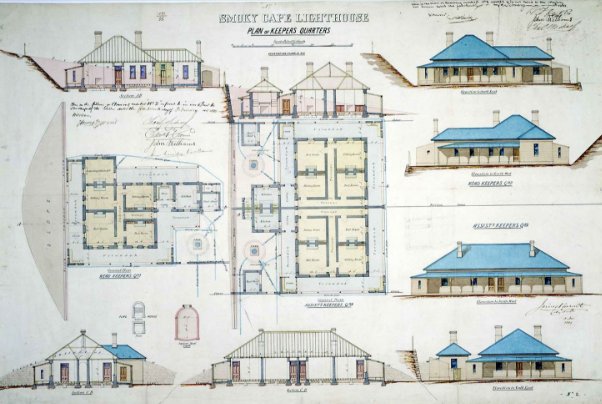
Figure 18. Design plan for Smoky Cape keepers’ cottages, 1880. Image courtesy of the National Archives of Australia. NAA: A9568, 1/17/3 (© Commonwealth of Australia, National Archives of Australia)
Reference List
Australian Maritime Safety Authority. AMSA Heritage strategy 2022-2025. 2022, https://www.amsa.gov.au/amsa-heritagestrategy-2022-2025.
Australian Maritime Safety Authority. Annual Report 2020-21. https://www.amsa.gov.au/about/corporatepublications/annual-report-2020-21.
AMSA, Interactive heritage lighthouse map, Google, 2021, https://www.operations.amsa.gov.au/lighthouses.
Ask First: a guide to respecting Indigenous heritage places and values. Australian Heritage
Commission, 2002.
Australian Heritage Database. Smoky Cape Lighthouse, Lighthouse Rd, South West Rocks, NSW, Australia. Department of Agriculture, Water and the Environment, http://www.environment.gov.au.
Australian Heritage Database. Smoky Cape Lighthouse (Commonwealth), Lighthouse Rd, South West Rocks, NSW, Australia. Department of Agriculture, Water and the Environment, http://www.environment.gov.au.
Brewis, C.R.W. Preliminary Report on the Lighting of the North Coast of Australia. Department of Trade and Customs, Commonwealth of Australia, 1912.
Brooks, G. and Associates PTY LTD. Smoky Cape Lighthouse Conservation Management and Cultural Tourism Plan. NPWS Lighthouses, 2001.
The Burra Charter: The Australia ICOMOS Charter for Places of Cultural Significance’. Australia ICOMOS, 2013.
Commonwealth of Australia. Engage Early—Guidance for proponents on best practice Indigenous engagement for environmental assessments under the Environment Protection and Biodiversity Conservation Act 1999 (EPBC Act). 2016.
Lucas, Stapleton and Partners PTY. LTD. Smoky Cape Lightstation Conservation Management Plan, 1994.
Marquis-Kyle, P., Heritage Lighthouse Report: Smoky Cape. Australian Maritime Systems Group, 2007.
National Archives of Australia: Australian Maritime Safety Authority; A9568, Drawings and Plans of Lighthouses and of Associated Buildings and equipment, 1833-1968; 1/17/1, Proposed Lighthouse: Smoky Cape: Plan of site showing position of Buildings: Area of Excavation: Levels etc [James Barnet - NSW Colonial Architect], 1888-1888.
National Archives of Australia: Australian Maritime Safety Authority; A9568, Drawings and Plans of Lighthouses and of Associated Buildings and equipment, 1833-1968; 1/17/2, Proposed Lighthouse: Smoky Cape [James Barnet - NSW Colonial Architect], 1888-1888.
National Archives of Australia: Australian Maritime Safety Authority; A9568, Drawings and Plans of Lighthouses and of Associated Buildings and equipment, 1833-1968; 1/17/3, Smoky Cape Lighthouse: Plan of Keepers Quarters [James Barnet - NSW Colonial Architect], 1888-1888.
National Archives of Australia: Department of Infrastructure, Regional Development and Cities, Central Office; A6247, Glass plate copy negatives of Australian coastal lighthouses, 1917-; 13/2, Lighthouses and Beacons - Smoky Cape, New South Wales, 1917-1917.
NSW National Parks and Wildlife Service. Hat Head National Park: Plan of Management. NSW NPWS, 1998.
NSW National Parks and Wildlife Service. Smoky Cape Walking Track. NSW NPWS, 2019. https://www.nationalparks.nsw.gov.au/things-to-do/walking-tracks/smoky-cape-walking-track/map.
NSW State Heritage Register. Smoky Cape Lightstation. Department of Premier and Cabinet. https://www.environment.nsw.gov.au/heritageapp/ViewHeritageItemDetails.aspx?ID=5045071.
Reid, G. From Dusk till Dawn: A History of Australian Lighthouses, Aus: Macmillan Co., 1988. Searle, S., First Order: Australia’s Highway of Lighthouses. Glenelg, SA: Seaside Lights, 2013.
Serle, G. First Order: Australia’s Highway of Lighthouses. Glenelg, SA: Seaside Lights, 2013.
Tomlinson, C. Tomlinson’s Cyclopaedia of Useful Arts. 1854.
Working Together Managing Commonwealth Heritage Places: a guide for Commonwealth agencies. Commonwealth of Australia, 2019.
“Wreck of the Annie Ogle,” The Sydney Mail and New South Wales Advertiser, March 20, 1875, https://trove.nla.gov.au/newspaper/article/162488354.
“The Wreck at Smoky Cape,” Macleay Argus, Nov 21, 1903, https://trove.nla.gov.au/newspaper/article/233738336.
“Smoky Cape Light,” The Sun, May 6, 1928, https://trove.nla.gov.au/newspaper/article/223216257
“Launch founders at Smoky Cape: Man bitten by shark,” Macleay Argus, Feb 12, 1937, https://trove.nla.gov.au/newspaper/article/234352865.
“Smoky Cape Tragedy,” The Manning River Times and Advocate for the Northern Coast Districts of New South Wales, Sept 6, 1947, https://trove.nla.gov.au/newspaper/article/172283536.
Endnotes




























































































































